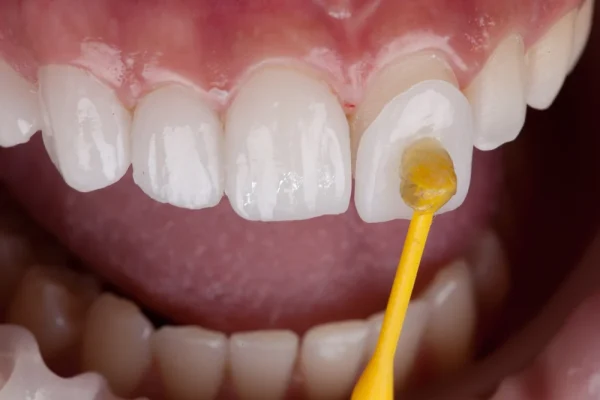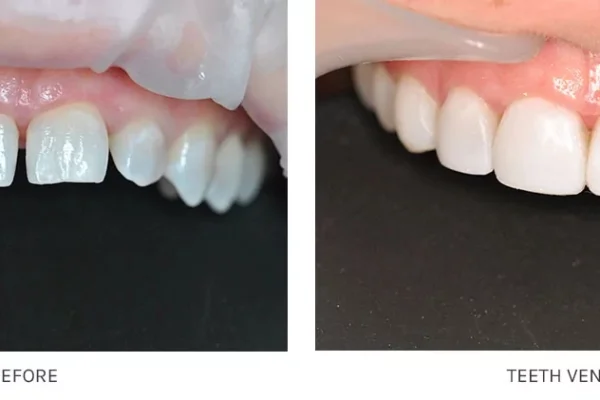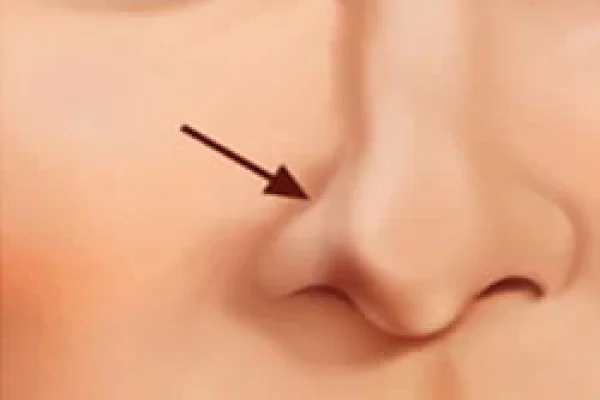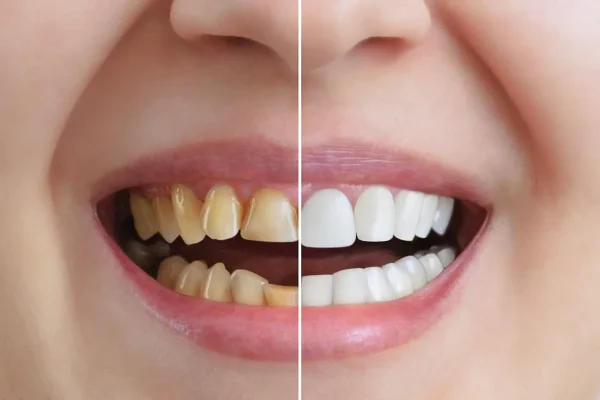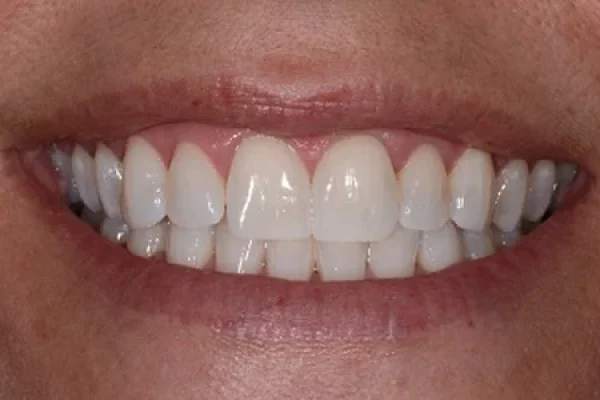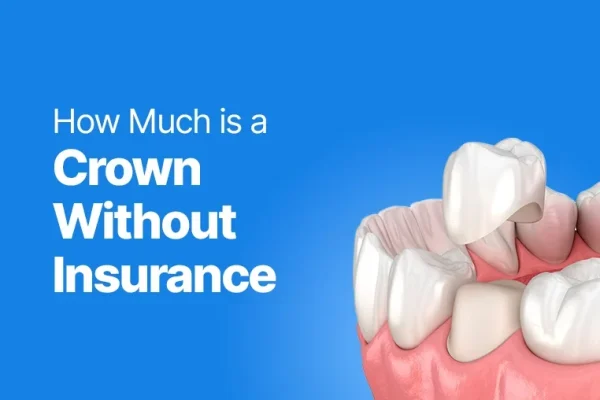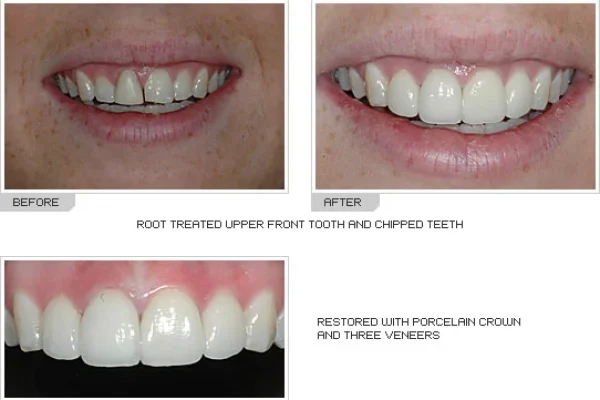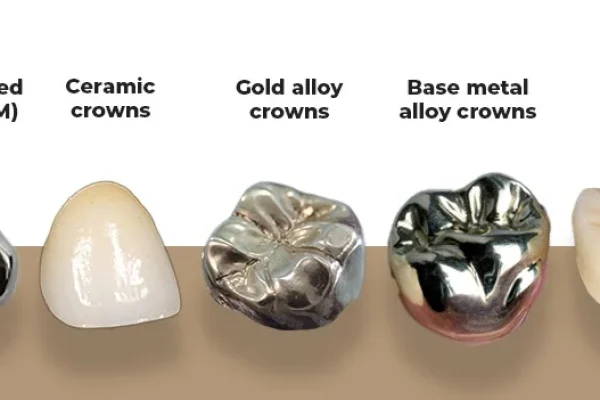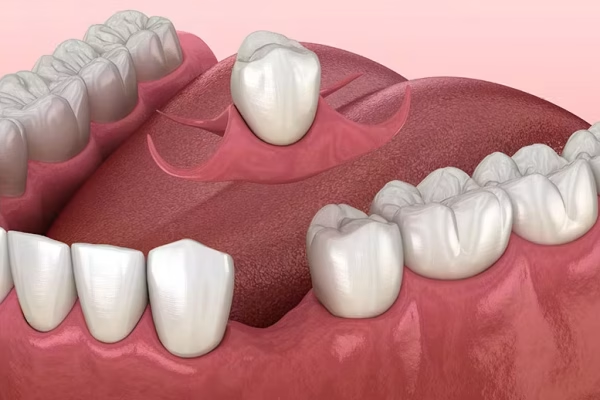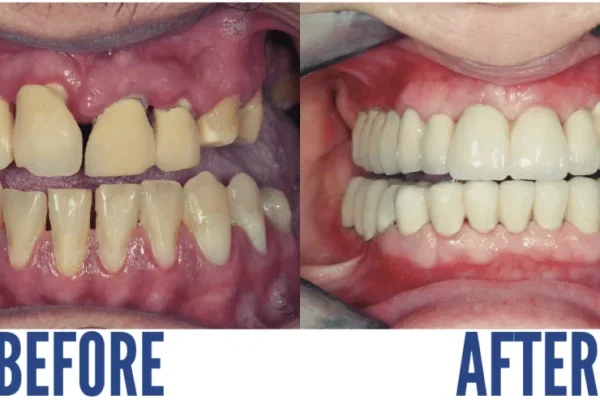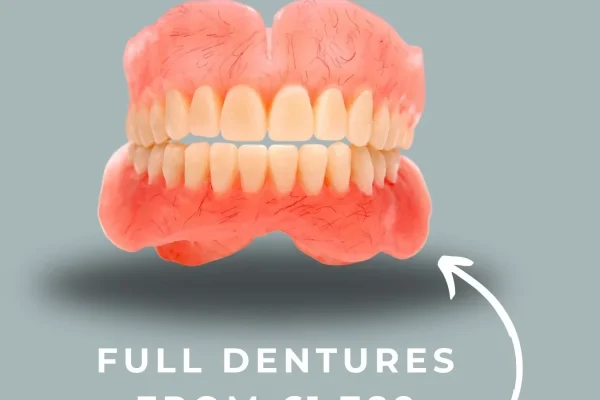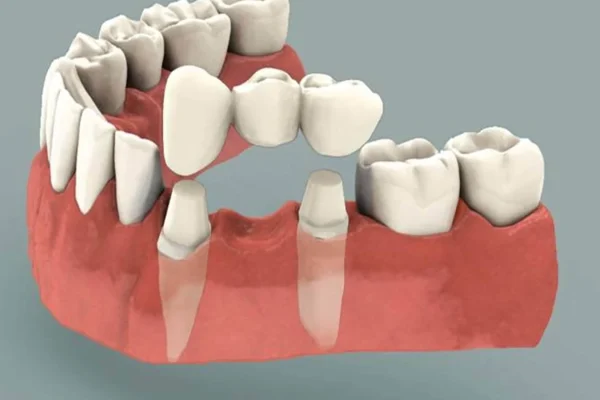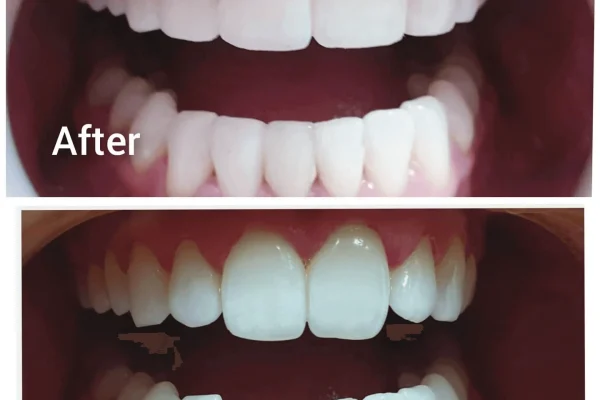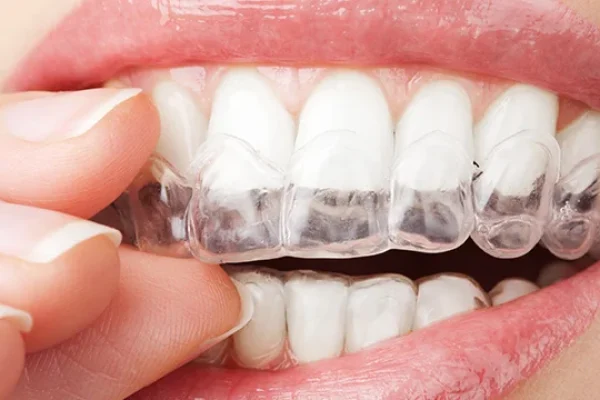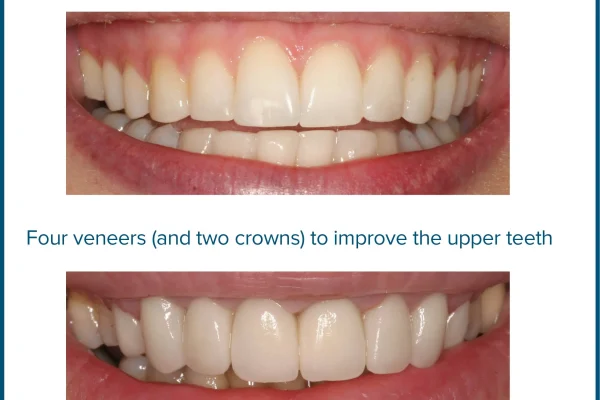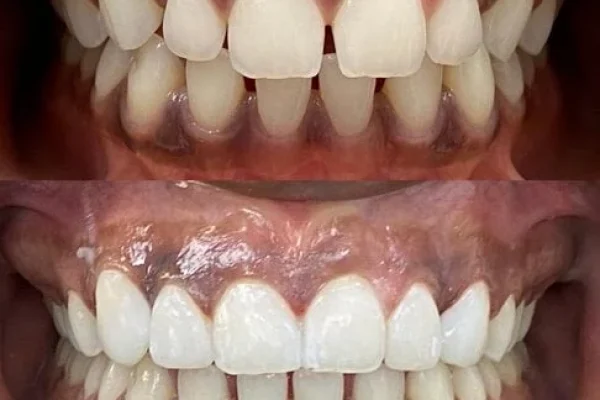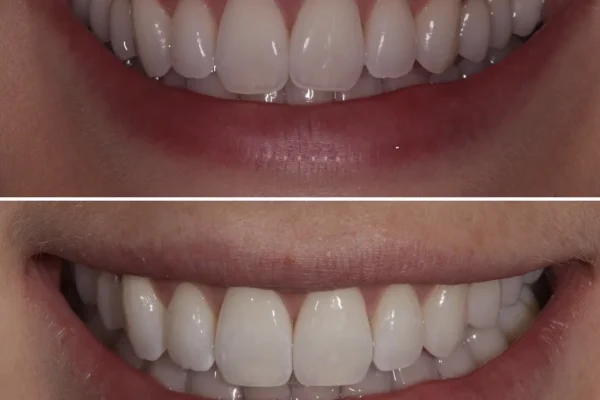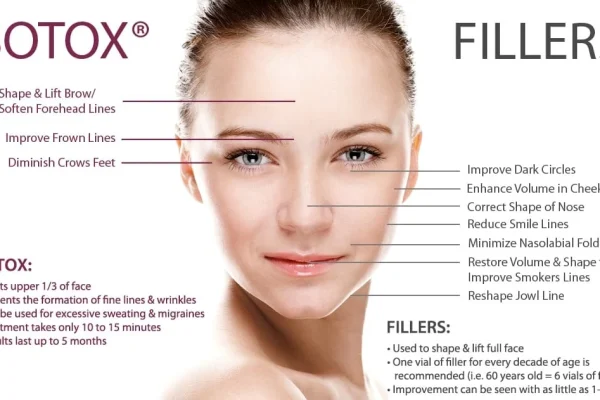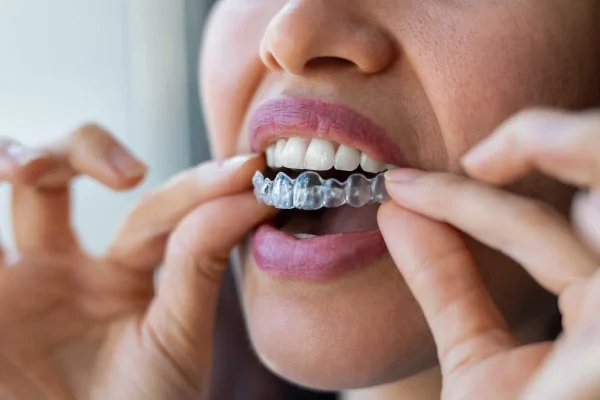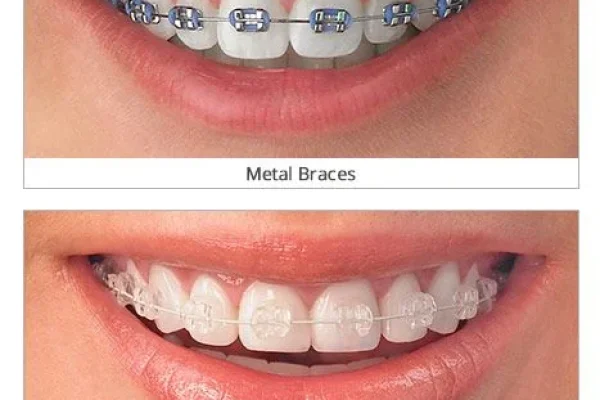
Table of Contents
ToggleKey Takeaways
- Composite bonding is a minimally invasive cosmetic dentistry procedure using tooth-colored resin.
- It effectively fixes chips, gaps, discoloration, and misshapen teeth.
- The procedure is typically painless, often completed in a single dental visit.
- Costs vary but are generally more affordable than alternatives like veneers; lifespan is approximately 3-10 years with proper care.
- Achieving natural-looking results heavily depends on the dentist’s skill; the resin can stain over time and cannot be whitened by traditional bleaching agents.
Alright, let’s dive deep into the dazzling world of cosmetic dentistry, specifically focusing on a treatment that’s been making waves for its subtlety, effectiveness, and accessibility. We’re talking about composite dental bonding, a true artist’s touch in the realm of smile enhancement. If you’ve ever caught yourself wondering about those seemingly minor dental imperfections – a slight chip here, a tiny gap there, or a tooth that’s just a shade off from its neighbours – then composite bonding might just be the transformative, yet understated, solution you’ve been seeking. It’s a procedure that bridges the gap between minor aesthetic desires and more invasive treatments, offering a path to a more confident smile without the extensive commitment often associated with other cosmetic dental work. Think of it as the bespoke tailoring of the dental world; it’s all about crafting a look that’s uniquely yours, enhancing what you already have, and polishing it to perfection. This comprehensive guide will illuminate every facet of composite dental bonding, from the foundational “what is it?” to the intricate details of cost, longevity, and candidacy. We’ll explore how this versatile treatment can address a multitude of cosmetic concerns, empowering you with the knowledge to decide if it’s the right step towards the radiant smile you deserve. Prepare to have your questions answered, your curiosities sated, and perhaps, your perception of cosmetic dentistry beautifully reshaped.
What Exactly is Composite Dental Bonding and How Does It Enhance Your Teeth?
Composite dental bonding, often simply referred to as “dental bonding,” “tooth bonding,” or sometimes more specifically as “composite resin bonding,” stands as a cornerstone of modern cosmetic dentistry, celebrated for its versatility and minimally invasive nature. At its core, this procedure involves the meticulous application of a tooth-colored composite resin – a durable, putty-like plastic material – directly onto the tooth surface. The primary purpose? To artfully conceal or repair a variety of aesthetic imperfections, thereby significantly enhancing the overall appearance of your smile. Imagine a sculptor carefully adding material to perfect a form; that’s akin to what a skilled dentist does with composite resin. Whether you’re looking to fix teeth that are chipped, cracked, slightly misaligned, discoloured, or have small gaps between them, composite bonding offers a remarkably effective solution. It’s a procedure where artistry meets dental science, as the dentist sculpts and shapes the resin to blend seamlessly with your natural teeth, matching both colour and contour. The terms “cosmetic bonding” or “teeth bonding” all point to this same transformative process. You’ll find that many dental practices, from your local family dentist to high-end cosmetic clinics, offer this service. When you see terms like “dentist bonding teeth,” or clinic-specific offerings like “Dental composite bonding | mydentist,” “Composite bonding – Damira Dental,” “Composite Bonding – Together Dental,” “Dental Composite Bonding | Space Dental,” “Composite Bonding Treatment | Dental Bonding | Watford Smiles,” “What Is Composite Bonding? | Before And After // 3Dental,” “Bonding | Widcombe Dental Practice | Dentists In Bath,” or “Composite Bonding – Maison Dental,” they are all referring to this ingenious technique. The beauty of composite bonding lies not just in its aesthetic outcomes but also in its conservative approach. Unlike veneers or crowns, which often require significant removal of the natural tooth structure, bonding typically necessitates minimal, if any, alteration to the existing tooth, preserving its integrity while still achieving a dramatic improvement in your smile’s radiance. This makes it an appealing option for those seeking noticeable results with a less aggressive treatment path.
What is Composite Tooth Bonding Specifically?
Delving deeper, “composite tooth bonding” zeroes in on the highly targeted and precise nature of this dental artistry. It’s not about a generalized approach; rather, it’s about the specific, customized application of composite resin to individual teeth or a select group of teeth to address distinct aesthetic concerns. Whether it’s a single “tooth composite” needing a touch-up after an accidental chip, or several “composite teeth” being subtly reshaped to create a more harmonious smile line, the procedure is tailored tooth by tooth. A particularly popular application is “composite edge bonding.” This technique focuses specifically on the incisal edges – the biting edges – of the front teeth. Over time, these edges can wear down, become uneven, or develop small chips. Composite edge bonding rebuilds these edges, restoring their natural, youthful contour and length, often making a surprisingly significant impact on the overall aesthetics of a smile with minimal intervention. The phrase “composite bonds teeth” succinctly describes the fundamental action: the resin material forms a strong, durable bond with the natural tooth structure. This bond is achieved through a microscopic etching of the tooth surface followed by the application of a conditioning liquid, which allows the resin to adhere securely. The success of composite tooth bonding lies in this robust adhesion, coupled with the dentist’s skill in sculpting the resin to achieve a look that is both beautiful and indistinguishable from the natural tooth. It’s a testament to how advanced dental materials, when wielded with precision and an artistic eye, can transform smiles with remarkable subtlety and effectiveness, one tooth at a time, enhancing specific features or correcting minor flaws that might otherwise detract from one’s confidence. This specificity is what makes it a go-to for targeted improvements, ensuring that only the areas needing attention are addressed, preserving the maximum amount of natural tooth.
What Does Composite Bonding Do for Your Smile?
The transformative power of composite bonding on your smile is both immediate and, quite often, remarkably profound, despite its generally conservative nature. Its primary function is to elevate the aesthetic appeal of your teeth by addressing a spectrum of common cosmetic imperfections. Think of it as a masterclass in dental camouflage and enhancement.
If you have teeth that are chipped from an old injury, or perhaps have developed small cracks over time, composite bonding can seamlessly fill these imperfections, restoring the tooth’s original smooth surface and structural integrity.
For those conscious of gaps between their teeth (diastemas), bonding offers a non-orthodontic solution to close these spaces, creating a more uniform and complete smile.
Discoloration is another key area where bonding shines; while deep, intrinsic stains might require other treatments, composite resin can be layered over mildly discoloured teeth or individual teeth that don’t match the rest, providing a consistent and brighter shade.
Beyond repair, composite bonding is exceptionally adept at improving tooth shape and size. A tooth that appears too small, too short, or has an irregular shape can be artfully augmented with resin, sculpted to achieve more desirable proportions and symmetry with its neighbours. This careful reshaping contributes significantly to a more harmonious and balanced smile line.
It’s no wonder that composite bonding is a highly popular choice within “bonding cosmetic dentistry” for achieving “cosmetic teeth bonding.” The procedure allows for a highly customized outcome, where the dentist works like an artist, carefully selecting shades of resin to perfectly match your natural teeth and meticulously shaping the material to achieve a result that is both beautiful and incredibly natural-looking. The ultimate goal is to enhance your existing smile, not to create an artificial one, leading to a boost in confidence that comes from feeling great about your appearance.
Why Is Composite Bonding Necessary for Certain Dental Issues?
While “necessary” might sound strong for a procedure often categorized under cosmetic dentistry, composite bonding indeed becomes a vital and highly recommended solution for a range of dental issues where aesthetics and minor functional restoration intersect. Its “necessity” stems from its unique ability to provide effective, conservative, and often immediate solutions.
For instance, when dealing with minor chips or fractures, especially on front teeth, composite bonding is often the first line of defense. Leaving a chip unaddressed can sometimes lead to further cracking or sensitivity, and it certainly impacts the smile’s appearance. Bonding seals the chip, prevents further damage, and restores the tooth’s natural look.
Similarly, for small gaps between teeth, while orthodontics is an option for more complex alignment issues, composite bonding provides a quicker, less invasive, and more affordable way to close these spaces, improving both aesthetics and potentially preventing food trapping.
When discoloration is limited to a few teeth or isn’t responsive to traditional whitening methods, bonding offers a way to achieve a uniform shade across the smile without resorting to more aggressive treatments like veneers for every tooth.
The role of “composite for teeth” extends beyond just looks; it acts as a restorative material that can also protect vulnerable areas of a tooth. Its “Minimally Invasive, Quick, and Affordable” attributes are precisely why it’s often deemed necessary or, at the very least, the most prudent choice. The procedure typically requires little to no removal of healthy tooth enamel, preserving the natural tooth structure. It’s usually completed in a single dental visit, offering immediate results. And, compared to alternatives like porcelain veneers or crowns, composite bonding is generally more budget-friendly. This combination of benefits makes it an indispensable tool in a dentist’s arsenal for addressing specific cosmetic and minor structural concerns efficiently and effectively, providing patients with a strong, beautiful, and healthy outcome.
What Does the Composite Bonding Procedure Entail and Is It Painful?
Embarking on the journey of composite bonding is often a surprisingly straightforward and comfortable experience, a far cry from the more involved dental procedures many might imagine. The typical “Composite Bonding Treatment Process” is renowned for its efficiency and minimal invasiveness, making it a popular choice for those seeking significant aesthetic improvements without extensive chair time or discomfort. Generally, the entire process for one or several teeth can be completed in a single dental visit, although this can vary depending on the complexity and number of teeth being treated.
The initial and crucial step is the “Composite Bonding Consultation & Planning” phase. During this consultation, you’ll discuss your aesthetic goals with your dentist. What aspects of your smile are you hoping to change? Are you looking to close gaps, repair chips, alter tooth shape, or improve colour? Your dentist will thoroughly examine your teeth and gums to ensure they are healthy and that bonding is the most appropriate treatment for your specific needs. This is also when the shade of the composite resin will be meticulously selected, using a shade guide to ensure the final result blends seamlessly and naturally with your surrounding teeth.
The beauty of composite bonding lies in the fact that the process usually involves minimal tooth preparation. Unlike treatments such as porcelain veneers or crowns, which often require significant enamel removal to accommodate the restoration, bonding typically preserves the vast majority of your natural tooth structure. This conservative approach is one of its most significant advantages, contributing to the overall health and longevity of the tooth. The dentist’s skill and artistic eye are paramount throughout the procedure, as they meticulously sculpt and shape the resin to achieve the desired aesthetic outcome, transforming your smile with precision and care.
How Does Composite Bonding Work Step-by-Step?
The actual application of composite bonding is a fascinating blend of dental science and artistry, unfolding in a series of precise, carefully executed steps. Once you and your dentist have agreed on the treatment plan and selected the perfect shade of composite resin, the procedure typically begins with the preparation of the tooth surface. This isn’t as daunting as it sounds; often, no anaesthesia is needed unless the bonding is being used to fill a decayed tooth.
The first real step is a gentle etching of the tooth surface. The dentist will apply a mild phosphoric acid solution to the area of the tooth being bonded. This solution creates a slightly rough, microscopic texture on the enamel. This etching process is crucial as it provides a better surface for the bonding material to adhere to, much like lightly sanding wood before painting. After a few seconds, the etching gel is rinsed off thoroughly, and the tooth is dried.
Next, the dentist applies a conditioning liquid, or bonding agent. This liquid, often a clear or tooth-colored primer, seeps into the microscopic pores created by the etchant and acts as an adhesive intermediary between the tooth and the composite resin itself. It ensures a strong, durable bond.
Then comes the star of the show: the “Composite Bonding – Colour Matching, Application, Curing” process. The tooth-coloured, putty-like composite resin, carefully matched to your natural teeth, is applied to the tooth in layers. The dentist skillfully sculpts and shapes the resin to repair the chip, fill the gap, or reshape the tooth according to the pre-agreed plan. This is where the artistic skill of the dentist truly comes into play.
Once the resin is perfectly placed and shaped, a special high-intensity curing light (often a blue light) is used to harden, or “cure,” the material. This light activates a catalyst within the resin, causing it to solidify and bond securely to the tooth in a matter of seconds per layer.
Finally, after the last layer of resin has hardened, the dentist will perform the final shaping and polishing. Using a series of fine burs and polishing discs, they will trim any excess material, further refine the shape, and polish the bonded tooth until it has a smooth, natural lustre that matches your other teeth. This meticulous finishing ensures the bonded tooth not only looks great but also feels comfortable and natural in your mouth.
Do They Shave or File Your Teeth Down for Composite Bonding?
This is a very common and understandable concern for anyone considering cosmetic dental work: will my natural teeth be permanently altered or reduced? One of the most appealing aspects of composite dental bonding is that, in most cases, extensive shaving or filing of your natural teeth is not required. This contrasts significantly with procedures like traditional porcelain veneers or crowns, where a noticeable amount of tooth enamel often needs to be removed to make space for the restoration and ensure a proper fit.
For composite bonding, the approach is far more conservative. The primary “preparation” involved is the aforementioned etching of the tooth surface. This is a very superficial process that creates microscopic roughness on the enamel to enhance the bond; it doesn’t significantly reduce the size or shape of the tooth. The idea is to preserve as much of your healthy, natural tooth structure as possible.
In some specific situations, a very slight amount of reshaping or smoothing of an existing jagged edge or a minor irregularity on the tooth surface might be done to create a better foundation for the resin or to achieve a more aesthetic final contour. However, this is typically minimal and is often described as “enameloplasty” – a gentle recontouring rather than aggressive shaving. The decision to do any minor reshaping is made on a case-by-case basis and will be thoroughly discussed with you by your dentist during the consultation phase. The goal is always to be as minimally invasive as possible.
This preservation of natural tooth enamel is a key advantage of composite bonding, as it means the procedure is often reversible (or more accurately, can be removed with minimal impact on the underlying tooth) and maintains the inherent strength of your tooth. So, rest assured, the vision of teeth being drastically filed down is generally not part of the composite bonding experience; it’s more about adding to and enhancing what’s already there.
How Painful is Composite Bonding Treatment Typically?
The question of “Does composite bonding treatment hurt?” is a frequent and perfectly valid one, as dental anxiety often revolves around the fear of pain. The good news is that composite dental bonding is generally considered a painless procedure for the vast majority of patients.
In most cases, especially when bonding is being done for purely cosmetic reasons like closing gaps, repairing small chips on the enamel, or reshaping teeth, anaesthesia (a numbing injection) is not even necessary. This is because the work is primarily done on the enamel surface, which doesn’t have nerve endings.
The etching process might cause a very brief, mild sensation for some, but it’s not typically described as painful. The application and sculpting of the resin itself is entirely pain-free. You might feel the dentist working, the instruments lightly touching your teeth, and the presence of the resin material, but there shouldn’t be any discomfort.
If, however, the composite bonding is being used to fill a cavity (decay) that is closer to the tooth’s nerve, or if a chip is very deep and near the sensitive dentin layer, your dentist will likely recommend and administer local anaesthesia to ensure you are completely comfortable throughout the procedure. This is standard practice for any restorative work that might approach sensitive tooth structures.
After the procedure, it’s also uncommon to experience pain. Some individuals might notice a slight temporary sensitivity to hot or cold in the bonded tooth, especially if a larger area was treated, but this usually subsides within a few days. Your dentist will provide specific aftercare instructions, but generally, you can expect a comfortable experience both during and after your composite bonding treatment, making it one of the most patient-friendly cosmetic dental options available for smile enhancement.
What is the Recovery Time After Dental Bonding?
One of the standout conveniences of composite dental bonding is the virtually non-existent recovery time. Unlike more invasive surgical dental procedures that might require a period of healing or specific post-operative care, dental bonding allows you to get back to your routine almost immediately.
Once the final layer of composite resin has been cured with the special light and your dentist has completed the shaping and polishing, the procedure is effectively complete, and the bonded material is fully hardened and functional. Patients can typically eat and drink normally right after leaving the dental office. There are no stitches to worry about, no significant swelling to manage, and generally no need for prescription pain medication.
While you can resume normal activities straight away, your dentist might offer a few simple recommendations for the first 24-48 hours to ensure the longevity and appearance of your newly bonded teeth. For instance, they may advise avoiding very hard, sticky, or crunchy foods initially, simply as a precaution, and suggest being mindful of consuming highly staining foods or drinks like coffee, tea, red wine, or curry, especially in the first day or two, as the resin can be slightly more susceptible to staining immediately after placement before it fully settles. However, these are usually minor cautions rather than strict limitations.
You might feel a slight awareness of the newly bonded areas for a short period, simply because the shape or feel of your tooth has changed, but this sensation typically fades quickly as you adapt. In essence, the “recovery” is more about acclimatizing to your enhanced smile than healing from a procedure. This immediate return to normalcy, coupled with the instant aesthetic results, makes composite bonding an incredibly appealing option for those with busy lifestyles who want to improve their smile without significant downtime.
Is Composite Bonding Reversible, Meaning Can You Go Back to Normal Teeth After Composite Bonding?
The question of reversibility is a significant consideration for many patients exploring cosmetic dental treatments, and with composite bonding, the answer is generally quite positive, though with some nuances. Because composite bonding typically requires minimal to no removal of the original tooth enamel, it is often considered one of the most reversible cosmetic dental procedures available.
If you decide at a later date that you no longer want the bonding, or if it needs to be replaced or redone, a dentist can usually remove the composite resin material. The process of removal involves carefully polishing or grinding away the resin material, taking great care not to damage the underlying natural tooth enamel. Ideally, after the resin is removed, your natural tooth will be in much the same condition as it was before the bonding was applied, especially if no enamel was removed during the initial preparation. This is a major advantage over treatments like traditional porcelain veneers, which necessitate the permanent alteration of the tooth structure, making them an irreversible commitment.
However, the degree of “reversibility” can depend on a few factors. If any minor shaping or enameloplasty (slight recontouring of the enamel) was performed as part of the initial bonding preparation, then that alteration to the natural tooth would, of course, be permanent. Additionally, the skill of the dentist in removing the bonding is crucial to ensure the enamel remains unscathed.
While you *can* technically “go back to normal teeth after composite bonding” in many cases, it’s also important to consider why you might want to. If the bonding was placed to correct a chip or a gap, removing it would simply reveal the original issue again. Often, patients choose to have bonding redone or replaced as it wears over time, rather than removed entirely, to maintain the aesthetic benefits. So, while largely reversible, it’s always best to discuss your long-term expectations and the specifics of your case with your dentist.
Who is a Good Candidate for Composite Bonding and What Issues Can It Fix?
Determining if you’re a good candidate for composite dental bonding involves a combination of your aesthetic goals, the specific dental issues you wish to address, and your overall oral health. Generally, individuals looking for a conservative, effective, and relatively affordable way to improve the appearance of their smile are excellent candidates. The ideal candidate typically has good oral hygiene habits, including regular brushing, flossing, and dental check-ups, as healthy gums and teeth provide the best foundation for any cosmetic procedure.
Composite bonding is particularly well-suited for addressing minor to moderate cosmetic imperfections. If you have chipped or cracked teeth from an accident or wear, small to medium-sized gaps between your teeth (diastemas), teeth that are slightly discoloured or stained (especially if only a few teeth are affected and whitening isn’t the preferred option), or teeth that are mildly misshapen, undersized, or uneven, then composite bonding can offer a fantastic solution. It’s also frequently used as a finishing touch after orthodontic treatment to perfect the shape and alignment of teeth.
The question “Is Composite Resin Bonding Right For You? | Colgate®” often hinges on these criteria: the desire for aesthetic improvement of such issues, a commitment to maintaining good oral health, and realistic expectations about the treatment’s longevity and maintenance requirements. During your consultation, your dentist will assess your specific situation, discuss your desired outcome, and help you understand if composite bonding aligns with your needs and if you meet the criteria for being a strong candidate for this versatile and transformative dental treatment.
Who Cannot Have Composite Bonding?
While composite bonding is a versatile and widely applicable treatment, there are certain situations and conditions where it might not be the most suitable or recommended option. Understanding these contraindications is crucial for managing expectations and ensuring the best possible long-term outcome.
Individuals with very severe tooth damage, such as extensively fractured teeth or large areas of decay, may require more robust restorative solutions like crowns, which provide greater structural support. If the tooth is too compromised, bonding might not be strong enough to withstand biting forces.
Similarly, those with very large gaps between their teeth might find that while bonding can close them, the resulting teeth might look unnaturally wide; in such cases, orthodontic treatment to move the teeth into better alignment might be a more appropriate long-term solution.
Active gum disease (periodontitis) is another key contraindication. Gums need to be healthy before any cosmetic procedure is undertaken. If your gums are inflamed, bleeding, or receding, these issues must be addressed and resolved first, as healthy gums are essential for the longevity and aesthetic success of bonding.
People who suffer from severe bruxism – habitual teeth grinding or clenching – may also not be ideal candidates, or at least, may need to take extra precautions. The forces generated by grinding can put excessive stress on the composite resin, potentially causing it to chip, fracture, or wear down prematurely. A nightguard might be recommended if bonding is pursued.
Furthermore, individuals with poor oral hygiene habits may not achieve the best results, as plaque accumulation around the bonded areas can lead to staining, decay at the margins of the bonding, and gum inflammation, compromising both the appearance and lifespan of the restoration.
Finally, if the cosmetic concerns are extensive and involve multiple teeth with significant alignment or bite issues, a more comprehensive approach involving orthodontics or porcelain veneers might be more appropriate.
Can Front Teeth Be Bonded, and What About Composite Bonding on Lower Teeth?
Absolutely, front teeth are among the most common and ideal candidates for composite bonding. Given their prominent position in your smile, any imperfections on these teeth – chips, small gaps, discoloration, or uneven edges – are highly visible and can significantly impact your confidence. Composite bonding is exceptionally well-suited for addressing these aesthetic concerns on anterior (front) teeth due to the dentist’s ability to meticulously match the resin colour to your natural enamel and sculpt it for a seamless, natural-looking result. Many stunning smile makeovers are achieved by artfully bonding just a few front teeth.
The question of “can composite bonding be done on the lower teeth?” also has a resounding “yes” as an answer. Lower teeth, just like upper teeth, can suffer from chips, wear, gaps, and discoloration, and composite bonding is an equally effective solution for them. The principles and application process are essentially the same.
However, there can sometimes be additional considerations for lower teeth. For example, the bite relationship (how your upper and lower teeth meet) is crucial. If there’s a very tight bite or if the lower teeth experience significant shearing forces during chewing, the dentist will need to ensure the bonding is shaped and placed to withstand these forces and avoid premature chipping or wear. Sometimes, the visibility of lower teeth is less pronounced than upper teeth in a smile, which might influence the extent of treatment a patient opts for.
Ultimately, suitability for bonding on upper or lower teeth, or a combination, is determined on an individual basis after a thorough dental examination. Discussing “how many teeth do you get composite bonding on?” is a key part of the consultation. It could be a single tooth, a pair of teeth, or a more extensive treatment like “Composite Bonding on 8 Upper Teeth to Close Gaps and Create Even Lengths” to achieve a comprehensive smile enhancement.
Can Dental Bonding Be Used to Close Gaps, Repair Chipped or Cracked Teeth, or Reshape Teeth?
Yes, dental bonding is exceptionally versatile and highly effective for all these purposes, making it a cornerstone of cosmetic dentistry for targeted improvements. For “Dental Bonding for Gaps & Chips,” it’s often the go-to solution.
When it comes to closing gaps (diastemas) between teeth, particularly smaller to medium-sized ones, composite resin can be skillfully applied to the sides of the adjacent teeth, widening them slightly until the space is closed. The dentist carefully sculpts the resin to ensure the new tooth contours look natural and proportional, creating a more uniform and harmonious smile line without the need for orthodontics in many cases.
Repairing chipped or cracked teeth is another primary application. Whether it’s a small chip on the edge of a front tooth from an accident or a minor crack, the composite resin is applied to the damaged area, meticulously shaped to restore the tooth’s original form and strength, and then polished to blend seamlessly with the surrounding enamel. The result is often an invisible repair.
Furthermore, composite bonding excels when dentists need to “reshape or lengthen teeth.” If a tooth is naturally too small, peg-shaped (conical), or has worn down over time appearing too short, composite resin can be added to its surface or edge to “increase the size of a tooth” or alter its contours. This allows the dentist to create more aesthetically pleasing proportions, improve the symmetry of the smile, and even make teeth appear straighter by artfully adding material to specific areas. This capability to sculpt and modify tooth morphology with such precision and with a material that mimics natural tooth appearance is what makes composite bonding a powerful tool for achieving significant aesthetic enhancements with minimal intervention.
Is Bonding Suitable For Damaged & Discoloured Teeth?
Composite bonding is indeed highly suitable for addressing certain types of damaged and discoloured teeth, offering a conservative and aesthetically pleasing solution.
When we talk about “damaged teeth,” bonding is particularly effective for minor to moderate damage. This includes small to medium-sized chips, minor fractures that don’t compromise the overall structural integrity of the tooth, and areas of enamel wear, especially on the biting edges of front teeth. The composite resin material can be securely bonded to the damaged area, restoring the tooth’s original shape, strength (for minor damages), and appearance. It acts like a seamless patch, making the tooth look whole and healthy again. For more extensive damage, such as a tooth with a large fracture or significant structural loss, a crown might be a more appropriate and durable solution, as it provides greater protection and reinforcement.
Regarding “discoloured teeth,” composite bonding can be an excellent option, particularly when the discoloration is superficial, affects only a few teeth, or when teeth whitening treatments have not yielded the desired results or are not suitable (for example, if the discoloration is due to trauma or medication and is intrinsic). The dentist can select a shade of composite resin that is lighter and brighter than the discoloured tooth and apply it as a thin veneer-like layer over the visible surface. This masks the underlying discoloration and creates a new, more aesthetically pleasing tooth colour.
It’s important to note that for generalized discoloration across many teeth, professional teeth whitening might be the first recommended step. If whitening is performed, bonding can then be done afterwards, matching the new, lighter shade of the natural teeth. Additionally, composite bonding is often considered a great choice for “Composite Bonding – Suitability After Orthodontic Treatment.” Once teeth are straightened with braces or aligners, bonding can be used for the final touches – perfecting tooth shapes, closing any residual tiny spaces, or repairing minor wear that was present before or occurred during treatment. This combination ensures a truly polished and ideal final smile.
What Are the Main Benefits and Advantages of Dental Bonding?
Composite dental bonding stands out in the realm of cosmetic dentistry for a multitude of compelling benefits and advantages, making it a highly sought-after procedure for individuals looking to enhance their smiles without resorting to more invasive or costly treatments.
Perhaps one of its most celebrated attributes is its conservative nature; it typically requires minimal to no removal of healthy tooth enamel, thereby preserving the natural integrity of your teeth. This is a stark contrast to procedures like porcelain veneers or crowns, which often necessitate significant alteration of the tooth structure.
Another key advantage is its aesthetic versatility. Skilled dentists can meticulously match the composite resin to the natural shade of your existing teeth, ensuring that the bonded restorations blend seamlessly and appear incredibly natural. The material can be sculpted and polished to mimic the translucency and lustre of real enamel, delivering results that are both beautiful and subtle.
The speed of treatment is also a significant plus; in many cases, composite bonding for several teeth can be completed in just a single dental visit, offering immediate gratification and a transformed smile without a lengthy treatment timeline.
Furthermore, it’s generally one of the more affordable cosmetic dental procedures, providing a cost-effective way to address chips, gaps, discoloration, and minor misalignments. This accessibility makes a beautiful smile achievable for a broader range of people.
The procedure is also typically painless, often not requiring anaesthesia, which alleviates a common source of dental anxiety for many patients.
Finally, bonded teeth, if they happen to chip or stain in the future, can often be easily and relatively inexpensively repaired or re-polished, adding to the convenience and long-term appeal of this remarkable dental solution.
Is Composite Bonding Worth the Money Invested?
Deciding whether composite bonding is “worth the money” is a subjective assessment that depends heavily on individual priorities, the specific dental issues being addressed, and the perceived value of the aesthetic and functional improvements achieved. However, for a vast number of patients, the answer is a resounding yes, primarily due to its excellent balance of cost-effectiveness and significant aesthetic impact.
When compared to other cosmetic dental procedures like porcelain veneers or orthodontic treatments, composite bonding is generally considerably more affordable per tooth. This lower price point makes it accessible to a wider range of individuals who desire smile enhancements but may be working within a specific budget.
The “investment” in composite bonding often yields immediate and visible results, typically within a single dental visit. This quick transformation of chips, gaps, or discoloration can lead to a substantial boost in self-confidence and satisfaction with one’s appearance, which many people find invaluable.
Furthermore, the conservative nature of the procedure – preserving natural tooth structure – adds to its value proposition, as it avoids the more aggressive alterations required by some alternatives.
While composite bonding may not last as long as porcelain veneers and can be more susceptible to staining over time, its repairability is a key factor. If a bonded tooth chips or stains, it can often be easily and relatively inexpensively touched up or repaired, extending its lifespan and maintaining its appearance without the need for a complete replacement, which might be the case with a damaged veneer.
For those seeking a noticeable improvement in their smile’s aesthetics to address specific, minor-to-moderate imperfections, without a major financial outlay or invasive procedures, composite bonding frequently represents excellent value and a worthwhile investment in their smile and self-esteem.
Is Bonding Good for Your Teeth and Can Bonding Keep My Tooth Structure Intact?
Yes, generally speaking, composite bonding is considered “good for your teeth,” primarily due to its remarkably conservative approach and its ability to protect and preserve natural tooth structure. One of the hallmark advantages of this procedure is that, in most applications, “can bonding keep my tooth structure intact?” can be answered with a very positive affirmation.
Unlike treatments such as traditional porcelain veneers or crowns, which often require the removal of a significant layer of healthy tooth enamel to accommodate the restoration, composite bonding typically involves minimal to no alteration of the underlying tooth. The process usually begins with a gentle etching of the enamel surface, a microscopic roughening that aids in the adhesion of the resin. This etching is superficial and does not compromise the tooth’s overall strength or integrity.
By adding material to the tooth rather than significantly subtracting from it, bonding helps maintain the tooth’s natural robustness. In some instances, bonding can even offer a protective benefit. For example, if a tooth has a small chip or crack, applying composite resin seals the imperfection, which can prevent further damage, reduce sensitivity, and protect the tooth from bacteria that could lead to decay. It effectively reinforces the slightly weakened area.
Moreover, because the bonding material itself is biocompatible and adheres directly to the tooth, it doesn’t typically cause irritation to the gums or surrounding tissues when properly placed and polished.
The key to ensuring bonding is “good” for your teeth in the long run also lies in maintaining good oral hygiene. Regular brushing, flossing, and dental check-ups are essential to prevent plaque buildup around the margins of the bonding, which could lead to decay or gum issues, just as it can with natural teeth. But the procedure itself, when performed correctly on a suitable candidate, is inherently tooth-friendly and focused on preservation.
Is Composite Bonding Customizable and Repairable?
A resounding yes to both! The high degree of “Composite Bonding – Customizable” results and its inherent “Repairable” nature are two of its most significant and appealing attributes, contributing greatly to its popularity.
The customization begins with the wide array of shades available for the composite resin material. Dentists have access to an extensive palette, allowing them to select a shade (or even blend multiple shades) that perfectly matches the natural colour and translucency of your existing teeth. This meticulous colour matching is crucial for ensuring that the bonded restorations blend seamlessly and undetectably with your smile.
Beyond colour, the resin itself is a putty-like material that the dentist skillfully sculpts directly onto your tooth. This allows for an incredible level of artistic control to shape the resin to the desired contour, whether it’s to fill a chip, close a gap, lengthen a tooth, or alter its overall shape. The dentist can mimic the natural undulations, textures, and reflective properties of enamel, leading to highly individualized and natural-looking outcomes. This is far more bespoke in its direct application than lab-fabricated restorations.
Secondly, the repairability of composite bonding is a major practical advantage. Life happens, and even with care, bonded teeth can sometimes chip, stain, or wear over time, especially if subjected to excessive force or staining agents. Unlike porcelain veneers, which if damaged often require complete replacement of the entire veneer, composite bonding can typically be repaired quite easily and cost-effectively. If a small chip occurs, a dentist can often roughen the affected area and simply add new composite resin to restore its original shape and appearance, blending it with the existing bonding. Similarly, if the surface becomes stained or dull over time, it can often be re-polished to restore its lustre, or a thin new layer of resin can be added. This ease of repair makes maintenance more manageable and less expensive over the lifespan of the bonding.
Briefly, if considering local benefits like “What are the benefits of Composite Bonding in Market Rasen, Lincolnshire?“, these fundamental advantages of customization and repairability apply universally, enhanced by the specific skill and service of a local practitioner.
What Are the Downsides, Disadvantages, Risks, and Potential Problems of Composite Bonding?
While composite dental bonding offers a wealth of benefits and is an excellent solution for many, it’s essential for prospective patients to have a balanced understanding, which includes acknowledging its potential “Composite Bonding – Risks & Limitations.” No dental procedure is entirely without its downsides, and being aware of these can help you make a fully informed decision and set realistic expectations.
One of the primary considerations is the material’s durability and lifespan. Composite resin, while strong, is generally not as robust or wear-resistant as porcelain (used in veneers and crowns) or natural tooth enamel. This means that bonded restorations may be more prone to chipping, fracturing, or wearing down over time, especially if subjected to heavy biting forces, habits like nail-biting or ice-chewing, or teeth grinding (bruxism). Consequently, composite bonding typically doesn’t last as long as porcelain veneers, often requiring touch-ups or replacement every 3 to 10 years, depending on factors like oral hygiene, diet, and the location of the bonding.
Another notable disadvantage is its susceptibility to staining. Unlike porcelain, which is highly resistant to stains, composite resin is more porous and can absorb pigments from food and drinks like coffee, tea, red wine, and tobacco over time. This can lead to the bonded areas becoming discoloured or no longer perfectly matching the surrounding natural teeth, which may necessitate re-polishing or replacement sooner than anticipated.
The aesthetic outcome, while potentially excellent, is also highly dependent on the skill and artistic ability of the dentist performing the procedure. Achieving a truly seamless and natural look requires meticulous attention to detail in shade matching, sculpting, and polishing.
While rare, there’s also a minimal risk of allergic reaction to the composite resin materials, though this is uncommon. Understanding these potential drawbacks allows for a more comprehensive conversation with your dentist about whether composite bonding is the optimal choice for your specific needs and lifestyle.
What Are the Downsides of Composite Bonding to Be Aware Of?
When considering composite bonding, it’s crucial to weigh its impressive advantages against some inherent downsides to ensure it aligns with your long-term dental goals and lifestyle.
A primary downside is its relative longevity compared to other cosmetic restorations like porcelain veneers. While composite bonding can last for many years with proper care (typically 3-10 years), porcelain veneers often boast a lifespan of 10-15 years or even longer. This means you might need to anticipate more frequent touch-ups, repairs, or replacements with bonding.
Another significant consideration is its susceptibility to staining. Composite resin is a porous material, and over time, it can absorb pigments from strongly coloured foods and beverages (think coffee, tea, red wine, curry) and from smoking. This can cause the bonded areas to discolour and potentially no longer match the shade of your natural teeth, which themselves may also change colour at a different rate. While regular polishing can help manage minor surface stains, deeper discoloration might necessitate replacement of the bonding.
Furthermore, while composite resin is quite durable for smaller restorations, it’s not as strong as porcelain or natural tooth enamel. This makes bonded teeth more prone to chipping, cracking, or wearing down, especially if you have habits like nail-biting, chewing on pens or ice, or if you grind your teeth (bruxism). For individuals requiring more extensive repairs or those with a very heavy bite, a stronger material like porcelain might be a more durable choice.
The aesthetic success of composite bonding is also highly dependent on the skill and artistry of the dentist. Achieving a perfectly natural look requires meticulous shade matching and sculpting, and results can vary.
Finally, while generally less expensive per tooth initially, the potential need for more frequent replacements over a longer period could mean the cumulative cost might eventually approach that of longer-lasting alternatives for some individuals, depending on how long they wish the restorations to last and how well they are maintained.
What is the Dark Side or The Ugly Side of Composite Bonding?
Phrases like “the dark side” or “the ugly side of composite bonding” often emerge from patient experiences where expectations weren’t met or when the limitations of the material became apparent over time. While “ugly” might be a strong term, it points to potential aesthetic and functional disappointments if the procedure isn’t ideal for the situation or if maintenance is neglected.
One aspect that could be considered part of this “dark side” is the potential for noticeable staining or discoloration. If a patient is a heavy coffee drinker or smoker and doesn’t maintain meticulous oral hygiene, the once beautifully matched bonding can become noticeably darker or yellower than the surrounding natural teeth, creating an uneven and less attractive smile. Similarly, if the natural teeth are whitened *after* bonding is placed, the bonded areas will not lighten, leading to a colour mismatch that can be quite conspicuous.
Chipping and wear can also contribute to an “ugly” outcome. Small chips on the edges of bonded front teeth can create a ragged, unkempt appearance. If the bonding wears down unevenly, it can alter the bite or the aesthetic harmony of the smile.
Another potential issue arises if the bonding isn’t perfectly contoured or polished. Poorly finished bonding can have rough margins that trap plaque and food debris, leading to inflammation of the gums (gingivitis) around the bonded tooth, which can appear red, swollen, and unattractive. These margins can also be more prone to staining.
In some cases, if a very large area is bonded, or if the material is not adequately supported by underlying tooth structure, there’s a higher risk of fracture or complete debonding (the restoration falling off).
While skilled dentists strive to avoid these issues, they are inherent risks related to the material’s properties and the complexities of oral environments. Understanding these potential pitfalls underscores the importance of choosing an experienced dentist and committing to excellent home care and regular dental check-ups to keep your bonded smile looking its best.
Can Teeth Rot Under Composite Bonding?
This is a critical question and a common concern: can the natural tooth structure decay or “rot” underneath composite bonding? The composite bonding material itself does not rot, nor does it directly cause tooth decay. However, it is possible for decay to develop around the edges or margins of a bonded restoration if proper oral hygiene is not maintained or if the bond begins to fail over time.
Here’s how it can happen: composite resin is bonded to the tooth surface. If this bond isn’t perfect, or if it starts to degrade over years of use, microscopic gaps can form between the bonding material and the natural tooth. These tiny crevices can become havens for bacteria from plaque. If plaque is allowed to accumulate in these areas due to inadequate brushing and flossing, the bacteria will metabolize sugars from your diet and produce acids. These acids can then attack the natural tooth enamel adjacent to or underneath the edge of the bonding, leading to demineralization and eventually a cavity (dental caries or decay).
So, while the bonding material itself is inert in this regard, the interface between the bonding and the tooth is a vulnerable area. The same principle applies to any dental restoration, including fillings, crowns, and veneers.
Excellent oral hygiene is paramount. This means thorough brushing twice a day, paying special attention to the gumline and the areas where the bonding meets the tooth, and meticulous flossing daily to clean between the teeth and under the edges of any restorations.
Regular dental check-ups are also crucial. During these visits, your dentist can examine your bonded teeth, check the integrity of the restorations, and professionally clean areas you might miss. If any early signs of leakage or decay are detected, they can be addressed promptly, often before significant damage occurs. So, while teeth don’t rot *because* of bonding, they can certainly decay *around* bonding if oral hygiene is neglected.
What Are the Disadvantages of Teeth Bonding to Consider?
When weighing the pros and cons of teeth bonding, it’s essential to have a clear-eyed view of its disadvantages to make an informed decision that suits your individual needs and expectations.
As previously touched upon, a primary disadvantage is durability and lifespan. Composite resin, while aesthetically pleasing, is generally not as strong or long-lasting as porcelain (used in veneers or crowns) or even natural tooth enamel. This means it can be more susceptible to chipping, fracturing, or wearing down, especially if you grind your teeth, bite your nails, or frequently eat very hard foods. Consequently, you might find that bonded restorations need repair or replacement more frequently, typically every 3 to 10 years, compared to the 10-15+ years often cited for porcelain veneers.
Another significant factor is stain resistance. Composite resin is more porous than porcelain and can absorb stains over time from coffee, tea, red wine, smoking, and certain foods. This can lead to the bonding becoming discoloured and no longer matching your natural teeth, potentially requiring polishing or replacement to restore its appearance.
The aesthetic outcome is highly operator-dependent. The success and natural look of composite bonding rely heavily on the skill, experience, and artistic ability of the dentist. Achieving seamless colour matching, ideal contours, and a natural-looking finish requires a high level of expertise.
While generally less expensive upfront per tooth than porcelain veneers, the potential need for more frequent repairs or replacements over the long term could mean that the cumulative cost of maintaining composite bonding might, for some individuals, approach or even exceed that of a longer-lasting alternative.
Finally, while bonding can address a wide range of minor to moderate issues, it may not be the ideal solution for very extensive damage, extremely large gaps, or significant misalignment issues, where more robust or comprehensive treatments like crowns or orthodontics might be more appropriate and provide better long-term stability and aesthetics.
How Much Does Composite Bonding Cost in the UK and Is It Generally Affordable?
Navigating the financial aspect of any dental treatment is a crucial step, and understanding “Composite Bonding Cost” is no exception. In the UK, the cost of composite dental bonding can vary quite significantly based on a confluence of factors, but it is generally considered one of the more affordable cosmetic dental procedures, especially when compared to options like porcelain veneers or orthodontic treatments. This “Composite Bonding – Affordability & Accessibility” is a key reason for its popularity.
The price is typically quoted on a per-tooth basis. Several elements influence this per-tooth cost: the complexity of the case (a small chip repair will likely cost less than reshaping an entire tooth or closing a larger gap), the amount of time and material required, the geographic location of the dental practice (clinics in major cities or more affluent areas may have higher overheads and thus higher prices), and, importantly, the experience and reputation of the dentist performing the procedure. A highly skilled cosmetic dentist with advanced training in bonding techniques may charge more, but their expertise can often translate into superior aesthetic results and potentially greater longevity of the restorations.
It’s also worth noting that some clinics might offer a slight discount if multiple teeth are being bonded simultaneously as part of a smile makeover. While it’s difficult to provide an exact figure without a consultation, as a general ballpark, patients in the UK might expect to pay anywhere from £150 to £400 or more per tooth for composite bonding.
It’s always best to get a detailed, personalized quote from your chosen dentist after a thorough examination and discussion of your treatment goals. Many dental practices also offer payment plans or financing options to help make the treatment more manageable for patients’ budgets.
How Much Does a Full Set of Composite Bonding Typically Cost?
When considering a more comprehensive smile transformation with composite bonding, such as treating a “full set” of visible teeth (often the front 6 to 8 upper teeth, and sometimes lower teeth as well), the total cost will naturally be a multiple of the per-tooth price. There isn’t a standardized definition of a “full set” in dental terms for bonding, as it’s highly customized to the individual’s smile and aesthetic goals. Some patients might only need bonding on four teeth to achieve their desired look, while others might opt for eight or ten.
If we take the general per-tooth cost range in the UK (e.g., £150 to £400+), a “full set” involving, say, six teeth could range from £900 to £2400 or more. For eight teeth, this could be £1200 to £3200+. It’s important to remember these are rough estimates. Some clinics might offer a package price or a slight reduction in the per-tooth cost when a larger number of teeth are being treated simultaneously. For instance, a promotional offer like “Composite Bonding from £369 | Cosmetic Dentistry | The Gentle Dental” gives an example of a potential starting price point per tooth at a specific clinic, but the final cost for a full set would still depend on the total number of teeth and the complexity involved.
When discussing a “full set,” the consultation phase becomes even more critical. Your dentist will assess precisely which teeth would benefit from bonding to achieve your desired outcome, the extent of work needed on each tooth, and then provide a comprehensive treatment plan with a detailed breakdown of costs. It’s also worth inquiring about what’s included in the quoted price – does it cover any necessary pre-treatment work, follow-up appointments, or minor adjustments? Understanding the full scope and cost upfront is key to making an informed decision about proceeding with a more extensive composite bonding treatment.
What is the Cost of Composite Filling of Front Teeth Using Similar Materials?
It’s interesting to compare the cost of cosmetic composite bonding with that of a composite filling on a front tooth, as they both utilize similar tooth-coloured resin materials. However, their primary purpose, the extent of the procedure, and often the level of aesthetic detailing involved can differ, which influences the cost.
A standard composite filling is primarily a restorative procedure aimed at removing decay and filling the resulting cavity to restore the tooth’s function and integrity. While aesthetics are certainly a consideration for front tooth fillings, and dentists strive to match the filling colour well, the primary goal is health and function.
Cosmetic composite bonding, on the other hand, is often a purely elective procedure focused entirely on enhancing appearance – closing gaps, changing tooth shape, covering discoloration, or repairing chips that may not necessarily involve decay. This often requires a higher degree of artistic skill, more intricate sculpting, and potentially more chair time to achieve the desired aesthetic result.
Therefore, even if a similar amount of material is used, cosmetic bonding on a front tooth might be priced differently, often slightly higher, than a straightforward composite filling for a small cavity on the same tooth. The cost of a composite filling on a front tooth in the UK can vary, perhaps ranging from £80 to £200 or more, depending on the size and complexity of the filling and the factors previously mentioned (location, dentist’s experience). If the “filling” is very small and simple, it will be at the lower end. If it’s a larger, more complex restoration involving multiple surfaces of the tooth, it will cost more.
In essence, while the base material is similar, the application, purpose, and artistic demands often differentiate the pricing between a functional composite filling and an elective cosmetic bonding procedure, with the latter sometimes incurring a premium for the enhanced aesthetic focus and detailed work required to achieve a flawless cosmetic outcome.
Do NHS Dentists Do Composite Bonding for Cosmetic Purposes?
The availability of composite bonding on the NHS (National Health Service) in the UK is generally limited, particularly when the procedure is sought for purely cosmetic reasons. The NHS primarily focuses on providing dental treatments that are clinically necessary to maintain oral health, prevent disease, and restore function. This includes treatments like fillings for cavities, extractions, root canal treatments, and dentures.
Composite resin material *is* used by NHS dentists for fillings, including on front teeth where aesthetics are important. If you have a cavity or a chip on a front tooth that requires a filling for health reasons, an NHS dentist will likely use a tooth-coloured composite material, and this would be covered under the standard NHS dental charges (Band 2 treatment in England, for example, which covers fillings).
However, if you are seeking composite bonding solely to improve the appearance of your teeth – for instance, to close small natural gaps between healthy teeth, to make teeth look slightly longer or a different shape for aesthetic preference, or to cover mild discoloration on otherwise healthy teeth – this is typically considered cosmetic treatment and is therefore not usually available on the NHS.
Such elective cosmetic procedures, including composite bonding for purely aesthetic enhancement, are almost always provided on a private basis. This means you would need to pay the dentist’s private fees for the treatment.
It’s always best to discuss your needs and options with your NHS dentist. They can advise you on what treatments are available under the NHS for your specific situation and, if your desired treatment is purely cosmetic, they can explain their private fees or potentially refer you to a colleague who offers private cosmetic dentistry if they don’t provide it themselves.
How Long Does Composite Bonding Last and What Aftercare is Needed for Maintenance & Lifespan?
The longevity of composite dental bonding is a significant consideration for anyone investing in this smile-enhancing treatment. While not considered a permanent solution like some other dental restorations, well-maintained composite bonding can provide beautiful results for a good number of years. On average, patients can expect their “Composite Bonding – Maintenance & Lifespan” to range from 3 to 10 years.
Several factors influence exactly how long your bonding will last. These include:
- The location of the bonding in your mouth (front teeth often experience different forces than back teeth, though bonding is less common on molars for heavy chewing surfaces)
- The extent of the bonding (larger bonded areas might be slightly more prone to stress)
- Your individual bite and chewing habits
- And, crucially, your oral hygiene practices and dietary choices.
The skill of the dentist who places the bonding also plays a role; meticulously placed and polished bonding tends to last longer.
To maximize the lifespan and maintain the appearance of your composite bonding, diligent aftercare is essential. This involves more than just admiring your new smile; it requires a commitment to practices that protect the resin material.
Regular and effective oral hygiene is paramount: brushing twice daily with a non-abrasive fluoride toothpaste and flossing at least once a day helps prevent plaque buildup around the bonded areas, which can lead to staining and decay at the margins.
Attending regular dental check-ups and professional cleanings (usually every six months) allows your dentist to monitor the condition of your bonding, polish away any surface stains, and address any minor issues like small chips before they become bigger problems.
Being mindful of your diet and habits is also key; avoiding or minimizing consumption of highly staining foods and drinks, and refraining from habits like biting fingernails, chewing ice, or using your teeth to open packages, will help prevent premature wear, chipping, and discoloration of the composite resin.
What is the Typical Lifespan of Dental Bonding and How Long Will My Composite Bonding Last For?
The typical lifespan of dental bonding, as mentioned, generally falls within the range of 3 to 10 years. It’s a fairly broad range because individual experiences can vary significantly. When patients ask, “How long will my composite bonding last for?”, the answer is always “it depends.”
Factors directly under your control, such as meticulous oral hygiene (brushing twice a day with a soft-bristled brush and non-abrasive toothpaste, flossing daily) and attending regular dental check-ups and cleanings, play a massive role in extending the life of your bonding.
Your dietary habits are also critical; frequent consumption of hard, sticky, or very crunchy foods can put stress on the bonded areas and potentially lead to chipping or dislodgement. Similarly, habits like nail-biting, pen-chewing, or using teeth as tools are detrimental.
The location of the bonding matters too; bonding on the biting edges of front teeth might experience more direct force than bonding on the facial surfaces. The extent of the original dental issue being corrected can also be a factor; larger bondings might be under more stress than very small ones.
When considering “Is bonding on teeth permanent?”, the clear answer is no. Unlike some dental work that aims for multi-decade longevity, composite bonding is understood to be a semi-permanent solution that will eventually require repair, touch-up, or complete replacement to maintain its optimal appearance and function.
However, the good news is that when it does need attention, it can often be easily repaired or resurfaced by your dentist. By being diligent with care and mindful of habits, many patients find their composite bonding serves them beautifully towards the longer end of that 3-10 year spectrum, providing a cost-effective and aesthetically pleasing smile enhancement for a significant period.
What Can’t You Eat with Composite Bonding, for Instance, Can You Eat an Apple or Crisps with Bonded Teeth?
After getting composite bonding, especially in the initial period and for long-term care, it’s wise to be mindful of certain foods to protect your investment and prevent damage. While you don’t need to adopt an entirely restrictive diet, some caution is advised. So, “What can’t you eat with composite bonding?” isn’t about a long list of forbidden foods, but rather about awareness.
Immediately after the procedure, your dentist might advise you to avoid very hard, sticky, or crunchy foods for the first 24-48 hours as the bonding fully settles and to allow you to get used to it.
Regarding specific examples: “Can you eat an apple with bonded teeth?” Yes, generally you can, but it’s often recommended to cut apples into smaller, bite-sized pieces rather than biting directly into a whole, hard apple, especially if the bonding is on the very edges of your front teeth. This reduces the direct shearing force on the bonded area.
What about “Can you eat crisps with composite bonding?” Again, yes, but with some moderation and care. Some very hard or sharp-edged crisps could potentially chip delicate bonding if bitten into aggressively. It’s about being sensible.
The main categories of foods to be cautious with include:
- Very Hard Foods: Things like hard candies, ice cubes, nuts (especially unshelled or very hard varieties), popcorn kernels, and hard bread crusts can exert enough force to chip or fracture composite resin.
- Sticky Foods: Chewy sweets, toffees, caramels, and very sticky energy bars can potentially pull at or dislodge bonding, particularly if the bonded area is large or if the bond isn’t perfectly optimal.
- Tough Meats: Chewing on very tough cuts of meat or gnawing on bones can also put undue stress on bonded teeth.
While you don’t have to live in fear of eating, adopting slightly more careful eating habits, like cutting up harder foods and avoiding using your bonded front teeth as “tools” for tearing or opening things, will significantly contribute to the longevity of your composite bonding.
Can You Drink Coffee with Composite Bonding and What About Other Staining Drinks/Foods?
Yes, you can drink coffee with composite bonding, but this is where the material’s susceptibility to staining comes into play, and caution is advised if you want to maintain that pristine, perfectly matched colour for as long as possible. Composite resin, being more porous than natural enamel or porcelain, can absorb pigments from various foods and beverages over time.
Coffee is a notorious staining agent due to its dark pigments (chromogens). So, while an occasional coffee is unlikely to cause immediate or drastic staining, regular and frequent consumption, especially if you sip it slowly over long periods, can gradually lead to your bonded teeth taking on a yellowish or brownish tinge.
The same applies to other staining drinks and foods. Tea (especially black tea), red wine, cola, dark fruit juices (like berry or grape juice), soy sauce, balsamic vinegar, curries, and berries (like blueberries and blackberries) are all known for their potential to stain.
To minimize staining from coffee and these other culprits, consider the following tips:
- Drink in Moderation: Reducing the frequency and quantity of consumption is the most straightforward approach.
- Use a Straw: For cold staining beverages like iced coffee, tea, or cola, drinking through a straw can help bypass the front surfaces of your teeth where bonding is often placed.
- Rinse Your Mouth: After consuming staining drinks or foods, rinse your mouth with plain water. This helps to wash away some of the chromogens before they have a chance to settle on the tooth surface.
- Maintain Excellent Oral Hygiene: Regular brushing (twice a day) with a non-abrasive whitening toothpaste (consult your dentist about suitable brands) and flossing can help remove surface stains.
- Regular Professional Cleanings: Your dental hygienist can polish your teeth, including the bonded areas, which can help remove some extrinsic (surface) stains and keep your smile looking brighter.
While you don’t have to give up your favourite coffee entirely, being mindful of its staining potential and taking proactive steps can help keep your composite bonding looking its best for longer.
What Happens After 5 Years of Composite Bonding, and What Does Composite Bonding Look Like After 5 Years?
The appearance and condition of composite bonding after 5 years can vary significantly from person to person, heavily influenced by the factors discussed earlier: oral hygiene, diet, habits, the initial quality of the bonding, and the specific location and extent of the bonded restorations.
For some individuals who are meticulous with their care and have favourable biting patterns, their composite bonding might still look excellent after 5 years – perhaps with only minimal wear or slight dulling of the lustre, which can often be rejuvenated with a professional polish. The colour match might still be very good, and the structural integrity intact.
However, for others, 5 years might mark a point where some noticeable changes have occurred. “What does composite bonding look like after 5 years?” could, in less ideal scenarios, mean that the resin has started to pick up some noticeable stains, particularly if the person frequently consumes coffee, tea, red wine, or smokes. The bonding might appear slightly yellower or darker than the adjacent natural teeth, especially if the natural teeth have also changed shade over time at a different rate.
Small chips or areas of wear might have developed, particularly on the biting edges if the individual has a heavy bite or habits like grinding. The surface might have lost some of its initial smooth, high-gloss finish and appear a bit duller. The margins where the bonding meets the natural tooth could also start to show slight staining or leakage if not perfectly maintained.
“What happens when composite bonding wears off?” isn’t usually a sudden event where the entire restoration falls off (though that can happen with trauma or a failed bond). More commonly, it’s a gradual process of wear, chipping, staining, or slight debonding at the edges.
This 5-year mark is often a good time for a thorough assessment by your dentist. They can evaluate the integrity of the bonding, check for any signs of wear, leakage, or decay around the margins, and discuss whether any touch-ups, re-polishing, repair, or full replacement might be beneficial to maintain optimal aesthetics and function.
How Do I Care for My Composite Bonding, Do Teeth Need Special Care, and How Do You Know When Composite Bonding Needs Replacing?
Caring for your composite bonding largely involves practicing the same excellent oral hygiene habits recommended for your natural teeth, but with a few specific considerations to maximize its lifespan and appearance. So, “How do I care for my composite bonding?” isn’t about a complex new routine, but rather an enhancement of good existing habits. Your teeth with bonding don’t necessarily need “special care” beyond what constitutes diligent oral hygiene, but an awareness of the material’s properties is key.
Here’s a breakdown:
- Brushing: Brush at least twice a day for two minutes each time using a soft-bristled toothbrush. Hard bristles can be abrasive and may dull the surface of the bonding over time. Use a non-abrasive fluoride toothpaste; some whitening toothpastes with harsh abrasives can also wear down the resin.
- Flossing: Floss daily, being careful yet thorough around the bonded teeth. This helps remove plaque and food debris from between the teeth and at the gumline, preventing decay and staining at the margins of the bonding.
- Dietary Habits: Be mindful of hard, sticky, and staining foods/drinks as previously discussed. Avoid using your bonded teeth to bite fingernails, open packages, or chew on pens or ice.
- Regular Dental Visits: See your dentist and hygienist for regular check-ups and professional cleanings (typically every 6 months). They can polish the bonding to remove surface stains and check for any signs of wear, chipping, or leakage.
“How do you know when composite bonding needs replacing?” Several signs can indicate it’s time:
- Noticeable Staining or Discoloration: If the bonding no longer matches your natural teeth and cannot be improved with polishing.
- Chipping or Fracturing: If parts of the bonding have broken off.
- Significant Wear: If the bonding has worn down, affecting your bite or the tooth’s appearance.
- Roughness or Dullness: If the surface has lost its lustre and feels rough.
- Visible Margins or Leakage: If you can see a distinct line or gap where the bonding meets the tooth, or if there’s recurrent decay around it.
- Aesthetic Dissatisfaction: If you’re simply no longer happy with how it looks.
Regarding “How many times can a tooth be bonded?”, generally, a tooth can be re-bonded multiple times, provided the underlying tooth structure remains healthy and sound. And to reiterate, “Is composite bonding a permanent treatment?” No, it is considered semi-permanent and will require maintenance and eventual replacement.
What Aesthetic Outcomes Can You Expect and Does Dental Bonding Look Natural?
The aesthetic outcomes achievable with composite dental bonding can be truly remarkable, often yielding a significantly enhanced yet incredibly natural-looking smile. When performed by a skilled and artistic dentist, “Composite bonding results” can seamlessly address a variety of cosmetic concerns, from minor chips and gaps to discoloration and misshapen teeth.
The primary goal of the procedure is always to achieve “Composite Bonding – Natural Looking Results,” meaning the bonded restorations should be virtually indistinguishable from your surrounding natural teeth.
This natural appearance is achieved through several key factors. Firstly, dentists have access to a wide spectrum of composite resin shades, allowing for precise matching to the unique colour and translucency of your individual enamel. They can even layer different shades and opacities of resin to mimic the subtle variations found in natural teeth, such as a more translucent incisal edge and a more opaque body.
Secondly, the composite material itself can be meticulously sculpted and shaped by the dentist directly on your tooth. This allows for a high degree of customization to create contours, surface textures, and light-reflective properties that replicate natural tooth morphology.
The final polishing stage is also crucial; a well-polished bonded tooth will have a smooth, high-gloss lustre that mirrors the shine of healthy enamel.
When these elements come together successfully, dental bonding can close gaps, repair chips, even out tooth lengths, mask discolorations, and generally create a more harmonious, symmetrical, and radiant smile, all while maintaining an appearance that looks like it’s entirely your own. Patients often report a significant boost in confidence following the procedure, delighted by how such a relatively conservative treatment can make such a positive impact on their overall look.
Can Composite Bonding Be Whitened or Can I Whiten Composite Bonding Later?
This is a very important question and a common point of consideration for patients: “Can composite bonding be whitened?” or “Can I whiten composite bonding later?” The straightforward answer is no, composite resin material does not respond to teeth whitening (bleaching) agents in the same way that natural tooth enamel does.
Whitening products, whether professional treatments from your dentist or over-the-counter kits, are designed to lighten the colour of natural tooth structure. The chemical agents in whiteners penetrate the enamel and break down discoloured molecules within the tooth. Composite resin, being a synthetic plastic material, does not have this porous organic structure and therefore will not change colour when exposed to these bleaching agents.
This has significant implications if you are considering both teeth whitening and composite bonding. If you desire a lighter overall shade for your smile, it is crucial to have your natural teeth whitened *before* you have composite bonding done. Once your natural teeth have reached the desired level of whiteness, your dentist can then select a shade of composite resin that perfectly matches this new, lighter shade.
If you have existing composite bonding and then decide to whiten your natural teeth, the bonded areas will retain their original colour while the surrounding natural teeth lighten. This will result in a noticeable colour mismatch, with the bonded teeth appearing darker or more yellow than the newly whitened natural teeth, which can be aesthetically undesirable.
If your existing bonding has become stained or discoloured over time, whitening your natural teeth won’t improve the colour of the bonding itself. In such cases, the stained bonding would likely need to be polished, repaired with a new surface layer of resin, or completely replaced to match the new shade of your natural teeth or to achieve a desired lighter shade overall.
Does Dental Bonding Look Natural, and What Do the “Composite Bonding Before and Afters” Show?
Yes, when performed with skill and artistry, dental bonding can look incredibly natural, often to the point where it’s virtually indistinguishable from your untouched teeth. The key to achieving this natural appearance lies in the dentist’s ability to meticulously replicate the subtle nuances of natural tooth enamel.
This includes precise shade matching, where the dentist selects from a wide palette of composite resin colours to find the perfect blend that harmonizes with your existing teeth. It also involves skillful sculpting of the resin to recreate the natural contours, surface texture, and light-reflecting properties of a tooth. A talented cosmetic dentist can even mimic the slight translucency often seen at the incisal edges of front teeth.
When you look at “Composite Bonding Before and Afters” photographs, which are widely available in dental practice portfolios and online galleries, you can witness the transformative power of this procedure. These images typically showcase dramatic improvements in smiles. You’ll see examples of chipped teeth flawlessly restored, unsightly gaps between teeth seamlessly closed, discoloured teeth brightened, and uneven or misshapen teeth beautifully recontoured.
What’s often most striking in high-quality before-and-afters is not just the correction of the imperfection, but how well the bonded restorations integrate with the rest of the smile. The “after” photos should ideally demonstrate teeth that look healthy, vibrant, and aesthetically pleasing, without appearing artificial or overly “done.” They serve as a powerful testament to the dentist’s skill and the versatility of the composite resin material.
These visual examples can give prospective patients a realistic idea of the potential outcomes and help them envision how bonding could enhance their own smile, reinforcing the fact that a natural, beautiful result is indeed achievable. They also highlight the importance of choosing a dentist with a good eye for aesthetics and proven experience in composite bonding techniques.
How Does Composite Bonding Compare to Alternatives Like Veneers?
When considering cosmetic dental enhancements, patients often find themselves weighing composite bonding against other popular treatments, most notably porcelain veneers. Understanding the key differences, advantages, and disadvantages of each can help you and your dentist make the most informed decision for your specific needs, aesthetic goals, and budget.
Both composite bonding and porcelain veneers are designed to improve the appearance of teeth by addressing issues like chips, gaps, stains, and minor misalignments. However, they differ significantly in terms of material, procedure, longevity, cost, and stain resistance.
Composite bonding involves the direct application and sculpting of a tooth-coloured resin material onto the tooth surface, typically completed in a single visit. It’s generally more conservative, requiring little to no removal of natural tooth enamel.
Porcelain veneers, on the other hand, are thin, custom-made shells of dental porcelain that are fabricated in a dental laboratory and then bonded to the front surface of the teeth. This process usually requires two or more dental visits and often involves the removal of a small amount of tooth enamel to accommodate the thickness of the veneer.
While both can deliver beautiful results, the choice between them often comes down to a trade-off between factors like invasiveness, upfront cost, durability, and long-term maintenance. A thorough discussion with your dentist about your priorities will illuminate which path is most suitable for your smile transformation journey, ensuring the chosen treatment aligns perfectly with your expectations and lifestyle.
What is Better, Veneers or Composite Bonding, and Should I Get Bonding or Veneers?
The question of whether porcelain veneers or composite bonding is “better” doesn’t have a one-size-fits-all answer, as the ideal choice depends entirely on individual circumstances, priorities, and the specific dental issues being addressed. Each option has its own set of advantages and disadvantages. “Should I get bonding or veneers?” is a decision best made after careful consideration and consultation with your dentist.
Composite Bonding Advantages:
- Typically less expensive upfront per tooth.
- The procedure is usually completed in a single visit.
- It’s more conservative, generally requiring minimal to no removal of natural tooth enamel, making it potentially reversible.
- Repairs are often easier and less costly if the bonding chips or stains.
Composite Bonding Disadvantages:
- Generally not as strong or durable as porcelain.
- More prone to staining over time.
- May not last as long as veneers, often requiring replacement or touch-ups every 3-10 years.
- The aesthetic outcome is highly dependent on the dentist’s skill in direct application.
Porcelain Veneers Advantages:
- Highly durable and resistant to chipping and wear.
- Extremely stain-resistant, maintaining their colour for many years.
- Can last significantly longer than composite bonding, often 10-15 years or more.
- Can provide a very high-end, luminous aesthetic result, capable of correcting more significant cosmetic issues.
Porcelain Veneers Disadvantages:
- Significantly more expensive upfront per tooth.
- The procedure typically requires at least two visits and often involves the irreversible removal of some natural tooth enamel.
- If a veneer chips or breaks, the entire veneer usually needs to be replaced.
The decision often comes down to:
- Cost: If budget is a primary concern, bonding is usually more affordable initially.
- Longevity & Durability: If you’re seeking the longest-lasting and most durable solution, veneers often have the edge.
- Conservativeness: If preserving natural tooth structure is paramount, bonding is less invasive.
- Aesthetic Goals: For minor imperfections, bonding can be excellent. For more dramatic smile makeovers or more severe discoloration/shape issues, veneers might offer a more comprehensive and stable solution.
The “Composite Bonding Vs Veneers: What’s the difference?” discussion with your dentist will explore these trade-offs in the context of your smile.
What is the Difference Between Composite Edge Bonding and Composite Veneers?
While both “composite edge bonding” and “composite veneers” (often called direct composite veneers or chairside veneers) utilize the same tooth-coloured composite resin material applied directly by the dentist, they differ in the extent of tooth coverage and the primary aesthetic goals they address.
Composite Edge Bonding:
As the name suggests, this technique focuses specifically on the incisal edges (the biting edges) of the teeth, usually the front ones. It’s primarily used to:
- Repair small chips or fractures on the tooth edge.
- Restore worn-down edges, adding length and improving the tooth’s contour.
- Smooth out uneven or jagged edges.
- Make subtle changes to the overall smile line by evening out the lengths of the front teeth.
Edge bonding is a very conservative treatment, often requiring no removal of natural tooth enamel. It’s about adding small amounts of resin to specific points on the edge to achieve a more refined and aesthetically pleasing look. Think of it as a targeted touch-up.
Composite Veneers (Direct Composite Veneers):
This procedure involves applying the composite resin to cover a larger portion, or often the entire visible front surface, of one or more teeth. It’s a more comprehensive approach used to:
- Make more significant changes to tooth colour, masking deeper stains or discoloration.
- Alter tooth shape and size more dramatically.
- Close larger gaps between teeth.
- Correct minor misalignments or rotations to give the appearance of straighter teeth.
While still generally conservative compared to porcelain veneers, direct composite veneers involve covering more tooth structure than simple edge bonding. The dentist layers and sculpts the resin over the tooth’s facial surface to create a new facade.
So, the key distinction in “Edge bonding vs composite veneers” lies in the area of application and the scope of aesthetic change. Edge bonding is for subtle refinements of the tooth’s biting edge, while composite veneers aim to transform the overall appearance of the tooth’s front surface. Both leverage the versatility and artistry of directly applied composite resin.
Are There Other Alternatives To Dental Composite Bonding to Consider?
Yes, while composite dental bonding is an excellent and versatile option for many cosmetic concerns, there are indeed other alternatives that might be more suitable depending on the specific dental issue, the patient’s goals, budget, and long-term expectations.
The most commonly discussed alternative is Porcelain Veneers, as already detailed. They offer superior durability and stain resistance but come at a higher cost and are more invasive.
For issues related to tooth alignment, such as crooked teeth or more significant gaps, Orthodontic Treatment (e.g., traditional braces, clear aligners like Invisalign) is often the ideal solution. Orthodontics physically moves the teeth into their correct positions, addressing the root cause of the misalignment rather than just camouflaging it. While treatment takes longer, the results can be permanent and offer functional benefits in addition to aesthetics.
If the primary concern is tooth discoloration, Professional Teeth Whitening (bleaching) can be a very effective and less invasive option than bonding or veneers, provided the teeth are otherwise healthy and well-shaped. Whitening can significantly lighten the natural shade of the enamel.
For teeth that are severely damaged, decayed, or structurally compromised, a Dental Crown (or “cap”) may be necessary. A crown covers the entire tooth, providing strength, protection, and restoring its shape and appearance. Crowns are more robust than bonding or veneers for heavily compromised teeth.
In some cases, a combination of treatments might be recommended. For example, a patient might undergo orthodontic treatment to align their teeth, followed by teeth whitening, and then perhaps some minor composite bonding or edge bonding for final refinements to tooth shape.
The best alternative depends on a thorough dental examination and a discussion with your dentist about your desired outcomes and the health of your teeth. They can explain the pros and cons of each relevant option to help you make an informed choice that aligns with your smile aspirations. For the question “How to fix missing teeth without implants?”, that’s a different category of treatment altogether, involving options like dental bridges or partial dentures, and isn’t a direct alternative to bonding for existing teeth.
What is the Post-Treatment Experience with Composite Bonding Like?
The post-treatment experience with composite dental bonding is generally very smooth and uneventful for most patients, contributing to its popularity as a minimally disruptive cosmetic procedure.
Immediately after the bonding is completed and polished, you can typically see the aesthetic improvements right away. There’s usually no significant pain or discomfort. Because anaesthesia is often not required, you won’t have to wait for any numbness to wear off, and you can usually eat and drink normally soon after leaving the dental office, though your dentist might advise avoiding very hard or sticky foods, or highly staining substances, for the first 24-48 hours as a precaution.
It’s not uncommon to be very aware of the newly bonded teeth for a short period. Your tongue might notice the new shapes or the feel of the resin, even if it’s perfectly smooth. This sensation of “newness” or slight strangeness usually fades within a few days as you become accustomed to the changes in your mouth.
Your bite should feel comfortable and normal; if you notice any high spots or discomfort when biting, you should contact your dentist, as minor adjustments can easily be made.
Long-term, the post-treatment experience revolves around good maintenance – regular brushing, flossing, and dental check-ups – to preserve the beauty and integrity of your bonded teeth. There are no special medications or complicated care routines required, just a commitment to consistent oral hygiene and being mindful of habits that could damage the restorations.
Most patients report high satisfaction with the immediate results and the ease of care following composite bonding.
Why Do My Teeth Feel Weird After Composite Bonding?
It’s quite common for teeth to “feel weird” for a short period after composite bonding, and this sensation is usually temporary and not a cause for alarm. There are several reasons why you might experience this.
Firstly, your tongue is an incredibly sensitive organ and is very attuned to the usual shapes and textures within your mouth. Even a subtle change in the contour, thickness, or length of a tooth due to the added composite resin can feel quite noticeable to your tongue initially. It might feel slightly bulkier, or the edges might seem different. This is simply your mouth adapting to the new topography.
Secondly, the surface texture of the newly polished composite resin, while smooth to the touch, might feel different from your natural enamel. Your brain needs a little time to register and accept this new sensation as normal.
Thirdly, if gaps were closed or chips were filled, the way your lips or tongue interact with those teeth will change, which can also contribute to a feeling of strangeness.
In some cases, if a very slight “high spot” remains on the bonding where it contacts the opposing teeth during biting, this can make your bite feel off or “weird.” This is something your dentist can easily adjust if it persists.
Rarely, some individuals might experience temporary, mild sensitivity to hot or cold temperatures in the bonded tooth, especially if a larger area was treated or if the bonding was close to the dentin layer. This sensitivity usually subsides within a few days to a week.
Generally, these “weird” feelings are part of the normal adaptation process and should resolve on their own as you get used to your enhanced smile. However, if the sensation is particularly bothersome, persists for more than a week, or if you notice any issues with your bite, it’s always a good idea to contact your dentist for a quick check-up and potential minor adjustments.
What If I Am Unhappy with My Composite Bonding Results?
While dentists strive for patient satisfaction, there might be instances where you find yourself unhappy with the results of your composite bonding. If this happens, the first and most important step is to communicate your concerns clearly and calmly with the dentist who performed the procedure. Reputable dentists want their patients to be happy with their work and are usually willing to discuss any issues.
There are several reasons why you might be dissatisfied: perhaps the colour match isn’t quite what you expected, the shape of the bonded teeth doesn’t look as natural as you’d hoped, the surface feels rough, or your bite feels uncomfortable.
Depending on the nature of your concern, several options might be available.
- Minor Adjustments: Often, issues like a slightly off bite, a small rough spot, or a minor contour irregularity can be easily addressed with some simple adjustments and polishing. Your dentist can reshape or smooth the resin to improve comfort and appearance.
- Re-contouring or Adding More Resin: If the shape isn’t quite right, it may be possible for the dentist to carefully re-contour the existing bonding or, in some cases, add a bit more resin to achieve the desired form.
- Complete Replacement: If the issues are more significant – for example, a major colour mismatch or a shape that you’re fundamentally unhappy with – it might be necessary to remove the existing bonding and have it redone. While this is a more involved solution, it’s often possible, especially since bonding is relatively conservative. Discuss with your dentist whether there would be additional costs involved in redoing the work.
- Exploring Other Treatments: In some rare cases, it might become apparent that composite bonding, even if redone, may not be able to achieve your specific aesthetic goals. At this point, your dentist might discuss alternative treatments, such as porcelain veneers, that could offer a different approach.
It’s crucial to have realistic expectations from the outset and to ensure you have a thorough consultation before the procedure, looking at before-and-after photos and clearly discussing your desired outcome. However, if you do find yourself unhappy, open communication with your dentist is key to finding a satisfactory resolution.
What Do Teeth Look Like When Composite Bonding is Removed?
When composite bonding is removed, the appearance of the underlying natural teeth largely depends on how much, if any, of the original tooth structure was altered during the initial bonding procedure.
One of the key advantages of composite bonding is its conservative nature; in many cases, especially for minor cosmetic enhancements like closing small gaps or repairing tiny chips, little to no enamel removal is required. In such ideal scenarios, if the bonding is carefully and skillfully removed by a dentist (usually by gently polishing or grinding away the resin material), the underlying natural tooth should look essentially the same as it did before the bonding was ever applied. It should retain its original shape, colour (though this may have changed naturally over time independently of the bonding), and surface integrity.
However, if any enamel was slightly reshaped or recontoured (enameloplasty) as part of the preparation for the bonding, then that minor alteration to the natural tooth will, of course, remain after the resin is removed. This is usually very minimal with bonding.
The process of removal itself needs to be done with care to avoid inadvertently scratching or damaging the natural enamel. A skilled dentist will use fine finishing burs and polishing instruments to gently take off the resin layer by layer.
After removal, the natural tooth surface might feel slightly different to your tongue for a short period if it had become accustomed to the resin, but visually, if no enamel was altered, it should appear largely unchanged from its pre-bonded state.
It’s important to remember that if the bonding was placed to correct an issue (like a chip or a gap), removing the bonding will simply reveal that original issue again. Patients usually opt to have bonding removed in order to replace it with new bonding, or perhaps to pursue a different cosmetic treatment, rather than simply returning to the pre-treatment state if there was an underlying aesthetic concern.
What General Information, Combined Discussions, and Testimonials Offer Further Insight into Composite Bonding?
Beyond the specific technical details, procedural steps, and cost considerations, a wealth of general information, combined discussions covering various facets, and patient testimonials can offer invaluable deeper insights into the world of composite dental bonding. These broader perspectives help paint a more complete picture, allowing potential patients to understand not just the “how” but also the “why” and the “what it’s really like.”
Combined discussions, such as articles or guides that holistically explore the “Pros And Cons Of Composite Bonding,” provide a balanced viewpoint, enabling individuals to weigh the benefits against the potential drawbacks in a structured manner.
Resources like “7 Things You Need to Know About Composite Bonding – Dental Beauty Harrow” often distil crucial information into easily digestible points, highlighting key takeaways that everyone considering the procedure should be aware of before making a decision.
Furthermore, firsthand accounts from those who have undergone the treatment, such as a “Composite Bonding Testimonial: Karen Byrne” (as a hypothetical example), can be incredibly enlightening. Testimonials offer a personal lens on the experience, detailing the patient’s initial concerns, their experience during the procedure, their satisfaction with the results, and how the bonding has impacted their confidence and daily life. They can address anxieties, showcase realistic outcomes, and provide relatable narratives.
General “Composite Bonding FAQ” sections on dental websites or in informational brochures are also excellent resources for quickly finding answers to common queries.
Even understanding general trends, like an estimate of “composite bonding cases per year” if such data were broadly available, can indicate the procedure’s popularity and widespread acceptance as a reliable cosmetic solution. Collectively, this type of information complements the clinical details, offering a more rounded and relatable understanding of what to expect from composite bonding.
What Are the Overall Pros And Cons Of Composite Bonding to Consider?
When considering composite dental bonding, a balanced understanding of its overall pros and cons is essential for making an informed decision. Many resources, such as articles titled “Pros And Cons Of Composite Bonding | Smile Stories,” aim to provide this comprehensive overview.
Pros (Advantages):
- Aesthetics: Capable of producing beautiful, natural-looking results, seamlessly blending with existing teeth to repair chips, close gaps, and improve tooth shape and colour.
- Conservative: Typically requires minimal to no removal of healthy tooth enamel, preserving the natural tooth structure. This makes it less invasive than options like porcelain veneers.
- Cost-Effective: Generally more affordable per tooth upfront compared to porcelain veneers or orthodontic treatments, making it accessible to a wider range of patients.
- Single Visit: Often, the entire procedure for one or several teeth can be completed in a single dental appointment, offering immediate results.
- Repairable: If the bonding chips or stains, it can often be easily and relatively inexpensively repaired or touched up by a dentist, rather than requiring a full replacement.
- Painless: The procedure is usually painless, often not requiring anaesthesia, which reduces dental anxiety for many.
Cons (Disadvantages):
- Durability & Lifespan: Composite resin is not as strong or durable as porcelain or natural enamel. It’s more prone to chipping, wearing down, and may need replacement every 3-10 years.
- Stain Resistance: Composite material is more porous than porcelain and can stain over time from coffee, tea, red wine, and smoking, potentially leading to a colour mismatch with natural teeth.
- Skill-Dependent: The quality of the aesthetic outcome is highly dependent on the skill and artistic ability of the dentist performing the direct application.
- Not for Major Issues: May not be suitable for very large restorations, severe misalignment, or heavy bite force situations where stronger alternatives are needed.
- Maintenance: Requires diligent oral hygiene and mindful eating habits to maximize lifespan and maintain appearance.
By carefully weighing these pros and cons in consultation with a dental professional, individuals can determine if composite bonding aligns with their specific cosmetic goals, budget, and lifestyle.
What Are the Key Things You Need to Know About Composite Bonding Before Deciding?
Before committing to composite dental bonding, arming yourself with essential knowledge can ensure your expectations are realistic and your decision is well-informed. Resources often highlight “7 Things You Need to Know About Composite Bonding – Dental Beauty Harrow” or similar key takeaways, which typically cover crucial aspects.
Firstly, it’s not permanent but it is long-lasting with care: Understand that composite bonding typically lasts between 3 to 10 years and will eventually need replacement or repair.
Secondly, composite resin can stain: Unlike porcelain, it’s susceptible to staining from dark foods, drinks, and smoking. Good oral hygiene and dietary mindfulness are crucial.
Thirdly, it cannot be whitened: If you desire whiter teeth overall, whiten your natural teeth *before* getting bonding, as the resin won’t change colour with bleaching agents. The bonding will be matched to your whitened teeth.
Fourthly, the procedure is generally conservative and often painless: Minimal tooth alteration is usually needed, and anaesthesia is often unnecessary.
Fifthly, results are highly dependent on the dentist’s skill: Choose an experienced cosmetic dentist with a good portfolio of bonding work for the best aesthetic outcome.
Sixthly, it’s more affordable upfront than veneers: This makes it a great option for cosmetic improvements on a budget, but consider long-term replacement costs.
Seventhly (and often implied through testimonials like a hypothetical “Composite Bonding Testimonial: Karen Byrne“), it can significantly boost confidence: Addressing cosmetic dental flaws can have a profound positive impact on self-esteem.
Beyond these, a general “Composite Bonding FAQ” can answer other specific queries. Understanding the prevalence, perhaps through indicative figures like “composite bonding cases per year” (if available generally), shows its acceptance. This core knowledge helps you engage more effectively with your dentist during the consultation and make a choice you’ll be happy with for years to come.
Where Can You Get Composite Bonding and Should You Consider Going Abroad For Dental Bonding?
Finding a qualified provider for composite dental bonding is a crucial step in achieving the beautiful and natural-looking results you desire. In most developed countries, including the UK, composite bonding is a widely available procedure offered by many general and cosmetic dentists. You can typically find dental practices offering this service in most towns and cities. The key is to find a dentist who not only offers the procedure but also has significant experience and a keen artistic eye for cosmetic work, as the quality of composite bonding is highly dependent on the skill of the practitioner.
When it comes to the question of “Considering Going Abroad For Dental Bonding?”, this has become an increasingly common consideration for various dental treatments, often driven by the allure of potentially lower costs – a phenomenon known as dental tourism. Countries in Eastern Europe, Turkey, and some parts of Asia are often marketed for more affordable dental care.
While cost savings can be a significant motivator, it’s essential to approach this option with thorough research and caution. There are potential risks and downsides to consider, such as varying standards of care and regulation, communication barriers, the difficulty of follow-up care or addressing complications once you’ve returned home, and the added expenses of travel and accommodation, which might offset some of the initial savings. It’s vital to meticulously vet any overseas clinic and dentist, checking their qualifications, accreditations, patient reviews, and before-and-after photos of their work specifically with composite bonding.
Are There Reputable Clinics for Composite Bonding, for Example, on Harley Street or in Areas Like Lincoln or Market Rasen?
Yes, absolutely. Reputable clinics and skilled dentists offering high-quality composite bonding can be found across the UK, ranging from renowned dental districts like Harley Street in London to well-regarded local practices in cities and towns such as Lincoln or Market Rasen. The key is not necessarily the geographical prestige of the address, but rather the qualifications, experience, and artistic skill of the individual dentist and the overall standards of the clinic.
Harley Street, London: Famous globally as a hub for medical and dental excellence, Harley Street (“Composite Bonding on Harley Street | Pro Dental Clinic,” “Composite Bonding & Veneers – Central London W1, UK – Harley Street Dental Studio“) is home to many highly experienced cosmetic dentists who specialize in procedures like composite bonding. These clinics often invest in the latest technology and materials and cater to a discerning clientele. While prices might be higher reflecting the location and expertise, the quality of work is generally expected to be very high.
Regional Cities and Towns (e.g., Lincoln, Market Rasen): You don’t need to travel to a major metropolis to find excellent dental care. Many highly skilled and reputable dentists practice in regional areas like “Composite Bonding Lincoln” or offer “Composite Bonding Market Rasen | Dental Bonding Lincolnshire” and “Composite Bonding in Market Rasen, Lincolnshire.” These local practitioners can provide equally outstanding composite bonding results, often with the added convenience of being closer to home and potentially at more competitive prices than central city locations.
The focus should always be on researching individual dentists and clinics, regardless of their location. Look for dentists with a special interest or further qualifications in cosmetic dentistry. Check their websites for before-and-after galleries of their composite bonding work, read patient reviews and testimonials, and consider scheduling a consultation to discuss your needs and get a feel for their approach. A good dentist will take the time to understand your goals and explain the procedure thoroughly.
Is Considering Going Abroad For Dental Bonding a Good Idea?
The decision to go abroad for dental bonding, often termed “dental tourism,” is a complex one with both potential benefits and significant risks that need careful consideration. The primary allure is often cost; dental treatments in some countries can be substantially cheaper than in the UK or other Western European nations. This can make extensive cosmetic work, including composite bonding on multiple teeth, seem much more affordable. Some overseas clinics are modern, well-equipped, and staffed by qualified professionals.
However, there are considerable downsides and potential pitfalls to be aware of.
- Standards of Care and Regulation: Dental regulations and standards of care can vary widely between countries. What might be standard practice or a required safety protocol in the UK may not be the case elsewhere. It can be challenging to verify the qualifications and accreditations of overseas dentists and clinics to the same degree you can at home.
- Communication Barriers: Language differences can lead to misunderstandings about your treatment plan, desired outcomes, or post-operative care. Clear communication is vital for successful cosmetic dentistry.
- Follow-up Care and Complications: If you experience complications, need adjustments, or require follow-up care after returning home, managing this can be difficult and costly. Your local dentist may be hesitant or unable to treat issues arising from work done abroad due to liability concerns or unfamiliarity with the materials or techniques used. Further trips abroad for corrections would negate much of the initial cost savings.
- Travel and Accommodation Costs: While the treatment itself might be cheaper, you need to factor in the costs of flights, accommodation, food, and time off work, which can add significantly to the overall expense.
- Risk of Rushed Treatment: Some overseas clinics catering to dental tourists might operate on tight schedules, potentially leading to rushed procedures, which can compromise the quality and longevity of composite bonding, a procedure that relies heavily on meticulous, unhurried application.
- Legal Recourse: If something goes wrong, seeking legal recourse or making a complaint can be far more complicated when dealing with a foreign jurisdiction.
While some people have positive experiences with dental tourism, it’s crucial to undertake extensive research, choose accredited clinics with verifiable credentials and excellent reviews, and weigh the potential savings against the inherent risks and lack of accessible aftercare. For a procedure like composite bonding, which often benefits from minor adjustments and relies on a strong dentist-patient relationship, the convenience and accountability of local care often outweigh potential overseas savings.
Frequently Asked Questions About Composite Dental Bonding
Navigating the world of cosmetic dentistry can bring up a myriad of questions, and when it comes to composite dental bonding, potential patients understandably want clear, concise answers to their most pressing concerns. This procedure, while relatively straightforward, has many facets, from the initial consultation and material science to the aesthetic outcomes and long-term maintenance. To help demystify the process and provide quick insights, we’ve compiled some of the most frequently asked questions. These address the fundamental nature of composite bonding, what the treatment experience is truly like, who stands to benefit most from it, the advantages it offers over other treatments, and the all-important cost considerations. Whether you’re just beginning to explore smile enhancement options or are seriously considering composite bonding, these FAQs aim to provide a solid foundation of knowledge. Each question delves into a critical aspect of the treatment, drawing from the detailed information discussed previously, to offer a quick yet comprehensive understanding. Think of this as your rapid-response guide to composite bonding, designed to equip you with the essential information you need at your fingertips, ensuring you feel confident and well-informed as you contemplate this popular and effective cosmetic dental solution. The goal is to address common curiosities and provide clarity, empowering you to engage in more productive discussions with your dental professional and make choices that align perfectly with your vision for a brighter, more confident smile.
What Exactly is Composite Dental Bonding and How Does It Enhance Your Teeth?
Composite dental bonding is a highly versatile and popular cosmetic dentistry procedure designed to improve the appearance of teeth with minimal invasion. At its heart, it involves the meticulous application of a tooth-colored composite resin – a durable, putty-like plastic material – directly onto the tooth surface. This resin is skillfully sculpted, shaped, and polished by the dentist to seamlessly blend with your natural teeth, effectively masking or repairing a variety of aesthetic imperfections. Its primary purpose is to enhance your smile by addressing issues such as chipped or cracked teeth, small to moderate gaps between teeth (diastemas), teeth that are discolored or stained (where whitening might not be effective or desired for isolated teeth), slightly misshapen or undersized teeth, and uneven tooth edges. The procedure is also known by several other terms, including “dental bonding,” “tooth bonding,” “composite resin bonding,” “cosmetic bonding,” or “teeth bonding,” all referring to this same technique of adding resin to improve dental aesthetics. The enhancement comes from the dentist’s ability to restore the tooth’s natural form, improve its color, and create a more harmonious and symmetrical smile line. Unlike more invasive procedures like porcelain veneers or crowns, composite bonding typically requires little to no removal of the existing tooth structure, preserving the tooth’s natural integrity while still achieving significant visual improvements. Many dental practices, from general family dentists to specialized cosmetic clinics, offer this service, making it a widely accessible option for those seeking a noticeable yet natural-looking boost to their smile’s radiance and their overall confidence, often in just a single visit.
What Does the Composite Bonding Procedure Entail and Is It Painful?
The composite bonding procedure is renowned for being relatively straightforward, efficient, and generally comfortable for the patient. It typically begins with a consultation where you discuss your aesthetic goals with your dentist, and they assess your suitability for the treatment. The shade of the composite resin is meticulously chosen to match your natural teeth. The actual “Composite Bonding Treatment Process” usually starts with minimal preparation of the tooth surface. In most cases, no significant drilling or removal of tooth enamel is required, which is a key advantage. The tooth surface is gently etched with a mild acidic solution to create microscopic roughness, which helps the bonding material adhere securely. A conditioning liquid (bonding agent) is then applied. Following this, the tooth-colored composite resin, which has a putty-like consistency, is applied in layers. The dentist skillfully sculpts and shapes the resin to the desired form, whether filling a chip, closing a gap, or altering the tooth’s contour. Each layer is hardened, or “cured,” using a special high-intensity light. Once the final shape is achieved and the resin is fully hardened, the dentist will meticulously trim any excess material and polish the bonded tooth to a smooth, natural-looking lustre that matches your other teeth. Regarding pain, “How painful is composite bonding treatment typically?” The answer is that it’s generally a painless procedure. For most cosmetic bonding applications, anaesthesia (numbing injection) is not necessary because the work is done on the enamel surface, which lacks nerve endings. You might feel the dentist working, but there shouldn’t be discomfort. If bonding is used to fill a cavity that’s closer to the tooth’s nerve, anaesthesia would be used. The “Recovery Time After Dental Bonding” is virtually nil; you can usually eat and resume normal activities immediately.
Who is a Good Candidate for Composite Bonding and What Issues Can It Fix?
An ideal candidate for composite bonding is typically someone with good overall oral health – healthy gums and teeth free of extensive decay – who is looking to address minor to moderate cosmetic imperfections. If you’re seeking a conservative, effective, and relatively affordable way to enhance your smile, bonding might be right for you. Key issues that composite bonding can successfully fix include: Chipped or Cracked Teeth: Small to moderate chips or cracks, especially on front teeth, can be seamlessly repaired, restoring the tooth’s original shape and integrity. Gaps Between Teeth (Diastemas): Bonding can close small to medium-sized gaps between teeth without the need for orthodontic treatment in many cases. Discolored Teeth: It can mask intrinsic stains or discoloration on individual teeth that don’t respond well to whitening, or if a patient wishes to change the color of a few specific teeth. Misshapen or Undersized Teeth: Teeth that are too small, peg-shaped, or have an irregular contour can be reshaped and resized with composite resin to create a more harmonious appearance. This includes “composite bonding can help increase the size of a tooth” or “reshape or lengthen teeth.” Uneven Edges or Worn Teeth: Bonding, particularly “composite edge bonding,” can restore worn biting edges, making teeth look more youthful and even. It’s also suitable for “Dental Bonding for Gaps & Chips” and can “repair chipped or cracked teeth.” The question “Is Composite Resin Bonding Right For You? | Colgate®” often boils down to whether your cosmetic concerns fall within this scope and if you prefer a minimally invasive approach. Individuals with severe tooth damage, very large gaps, significant orthodontic issues, or active gum disease might not be suitable (“Who cannot have composite bonding?”). It’s also effective “After Orthodontic Treatment” for final touch-ups.
What Are the Main Benefits and Advantages of Dental Bonding?
Composite dental bonding offers a compelling array of benefits and advantages, making it a highly attractive option for many individuals seeking cosmetic smile improvements. One of its most significant pros is its Conservative Nature: It typically requires minimal to no removal of healthy tooth enamel, preserving the natural integrity of your teeth (“Can Bonding Keep My Tooth Structure Intact?”). This is a stark contrast to more invasive procedures. Secondly, it delivers Excellent Aesthetic Results: Skilled dentists can meticulously match the composite resin to your natural tooth shade and sculpt it to achieve a seamless, natural-looking enhancement. The results are highly “Composite Bonding – Customizable.” Thirdly, it’s generally Cost-Effective: Compared to porcelain veneers or crowns, composite bonding is usually a more affordable cosmetic dental procedure per tooth, making it a good answer to “Is composite bonding worth the money invested?” Fourthly, the treatment is often Completed in a Single Visit: This means you can see immediate improvements to your smile without a lengthy treatment process. Fifthly, the procedure is typically Painless: In most cases, anaesthesia is not required, which helps alleviate dental anxiety. Sixthly, composite bonding is Repairable: If the bonded restoration chips or stains in the future, it can often be easily and relatively inexpensively repaired or re-polished by your dentist. Seventhly, its versatility means it can address a wide range of minor to moderate cosmetic issues, from chips and gaps to discoloration and misshapen teeth. These combined benefits explain why it’s a popular choice for those wanting noticeable yet natural improvements to their smile without extensive commitment or cost.
How Much Does Composite Bonding Cost in the UK and Is It Generally Affordable?
The “Composite Bonding Cost” in the UK can vary based on several factors, but it is generally considered one of the more affordable cosmetic dental treatments, enhancing its “Composite Bonding – Affordability & Accessibility.” The price is usually quoted per tooth. Factors influencing the cost include the complexity of the case (e.g., a small chip repair versus extensive reshaping), the amount of material and time required, the geographic location of the dental practice (costs may be higher in major cities), and the experience and expertise of the cosmetic dentist. On average, patients in the UK might expect the cost of composite bonding to range from approximately £150 to £400 or more per tooth. For a “full set of composite bonding,” which might involve treating, for example, 6 to 8 front teeth, the total cost would be a multiple of the per-tooth price. Some clinics, like the example “Composite Bonding from £369 | Cosmetic Dentistry | The Gentle Dental,” might advertise a starting price. It’s important to get a personalized quote after a consultation. When comparing to “the cost of composite filling of front teeth using similar materials,” cosmetic bonding might be priced slightly higher due to the greater emphasis on aesthetic detail and artistry involved, even though the base material is similar. Regarding NHS availability, “Do NHS dentists do composite bonding for cosmetic purposes?” Generally, no. The NHS covers clinically necessary treatments. While composite fillings for decay are available on the NHS, purely cosmetic bonding to improve appearance (e.g., closing natural gaps) is typically only available on a private basis. Many private dental practices offer payment plans to help make the treatment more manageable.




